Driving and Docking a Catamaran: Guide for Boaters
Catamarans have grown in popularity among boaters, both for recreational sailing and long-distance cruising. With their dual-hull design, they offer stability, speed, and ample space. However, driving and docking a catamaran is a unique experience compared to single-hull boats. This guide will take you through the essentials of operating and maneuvering a catamaran, covering its driving characteristics, docking tips, common challenges, and an overview of pricing and specifications for some popular models.

What Is a Catamaran?
A catamaran is a boat with two parallel hulls connected by a deck or bridge. This design provides more stability and reduces drag in the water, making catamarans faster and more efficient than monohull boats. Catamarans are known for their spacious interiors, increased living space on the deck, and shallow draft, making them perfect for coastal cruising and anchoring near shores.
There are two primary types of catamarans: sail-powered and power catamarans. Each has unique driving and docking considerations, which we’ll explore below.
Driving a Catamaran
Understanding the dual hulls.
Driving a catamaran differs from operating a monohull because of the boat’s width and the twin hulls. Here’s how the catamaran design affects driving:
- Stability : The wide stance of the hulls makes catamarans more stable, reducing rolling in rough seas. However, it also means they handle differently when turning and responding to wind or current.
- Manoeuvrability : Catamarans are agile, especially power catamarans, due to the ability to control each hull’s engine independently. This gives them better control, especially when docking or navigating tight spaces.
- Wind Influence : Catamarans are more susceptible to wind because of their large profile and lightweight design. Sail-powered catamarans especially benefit from their ability to harness wind, but this can make them tricky to drive in strong winds when compared to monohulls.
Key Differences in Driving a Catamaran
- Speed and Efficiency : Catamarans glide across the water with minimal drag, making them more efficient and often faster than their monohull counterparts. When driving, you’ll find that maintaining speed requires less fuel or wind power.
- Turning Radius : Catamarans tend to have a wider turning radius, requiring more space to make turns. However, with dual engines (on power catamarans), you can pivot the boat using differential thrust, making it possible to spin in place.
- Handling Waves : Unlike monohulls that cut through waves, catamarans ride over them. This makes for a smoother experience but also means that waves can impact both hulls differently, requiring you to adjust your steering.
Docking a Catamaran
Docking a catamaran requires a combination of skills and careful attention to the conditions. The wider beam, lighter weight, and susceptibility to wind present unique challenges. However, with some practice, catamarans can be docked smoothly and efficiently.
1. Approach at an Angle
When docking a catamaran, the first rule is to approach at an angle. This gives you more control and allows you to adjust for wind and current. A slow, controlled approach will help you compensate for any unexpected movements.
2. Use Differential Thrust
If your catamaran is equipped with twin engines, you can use differential thrust to your advantage. This involves using more throttle on one engine and less on the other to make precise movements, including rotating the boat to line it up with the dock.
3. Mind the Wind
Wind can have a significant impact when docking a catamaran, especially if the boat is light. Always dock into the wind if possible, as this gives you better control. If the wind is pushing you toward the dock, approach more slowly to avoid collisions.
4. Use Fenders and Lines
The width of a catamaran makes fender placement especially important. Place fenders along both sides of the boat to avoid damaging the hulls. Additionally, set up docking lines in advance, as this will help you secure the boat once it’s close to the dock.
5. Shallow Draft Considerations
One advantage of catamarans is their shallow draft, which allows you to dock closer to shore in many situations. However, be mindful of the depth and obstacles near the dock to prevent damage to the rudders or keels.
Common Challenges When Docking a Catamaran
- Wide Beam : The wide stance of a catamaran can make finding appropriate dock space more difficult, especially in crowded marinas.
- Windage : Catamarans are more susceptible to wind, especially when docked in open areas. Wind can easily push the boat off course, making docking more challenging.
- Limited Docking Space : Some docks aren’t designed to accommodate the wider beam of a catamaran, which may require special arrangements or berthing in less accessible areas.
Price and Specifications of Popular Catamarans
To help you understand the range of options available, here’s a look at a few popular catamaran models, including their specifications and price ranges.
1. Lagoon 42 (Sailing Catamaran)
- Length : 42 feet
- Beam : 25 feet
- Draft : 4.1 feet
- Engine : 2 x 57 HP
- Top Speed : 9-10 knots under sail
- Price : $600,000 – $750,000 (new)
- Features : The Lagoon 42 is a favorite among cruising enthusiasts, offering ample living space, a large cockpit, and easy handling. It’s ideal for long-term cruising and comes equipped with various modern amenities like solar panels and watermakers.
2. Fountaine Pajot MY 44 (Power Catamaran)
- Length : 44 feet
- Beam : 21.7 feet
- Draft : 3.8 feet
- Engine : 2 x 350 HP Volvo Penta
- Top Speed : 25 knots
- Price : $1.2 million – $1.5 million (new)
- Features : This luxury power catamaran offers high-performance engines, exceptional maneuverability, and a spacious, modern interior. With its twin-engine setup, docking is a breeze, and it’s perfect for long-distance cruising.
3. Leopard 45 (Sailing Catamaran)
- Length : 45 feet
- Beam : 24 feet
- Draft : 4.10 feet
- Engine : 2 x 45 HP
- Top Speed : 9-11 knots under sail
- Price : $700,000 – $850,000 (new)
- Features : Known for its robust build and reliability, the Leopard 45 is a versatile sailing catamaran that offers a well-appointed layout, plenty of deck space, and easy access to the helm for simplified docking.
4. Sunreef 50 (Luxury Catamaran)
- Length : 50 feet
- Beam : 30.8 feet
- Draft : 5.7 feet
- Engine : 2 x 80 HP
- Top Speed : 12 knots under sail
- Price : $1.7 million – $2.5 million (new)
- Features : Sunreef catamarans are synonymous with luxury. The Sunreef 50 is a perfect example, featuring expansive living quarters, a luxurious master suite, and customizable layouts. It’s ideal for those looking to cruise in style.
Driving and docking a catamaran is an exciting and rewarding experience, but it comes with unique challenges. Whether you’re handling a sailing catamaran or a power catamaran, understanding how to control the vessel’s dual engines, accounting for wind, and mastering differential thrust are key to a smooth ride and docking. With time and practice, you’ll find that catamarans offer unparalleled comfort, performance, and stability on the water.
If you’re considering purchasing a catamaran, it’s essential to consider your boating style, desired features, and budget. From the agile Lagoon 42 to the luxurious Sunreef 50, there’s a wide range of catamarans available, each designed to provide a unique experience on the water.
Whether you’re a seasoned sailor or new to boating, mastering the art of driving and docking a catamaran will open up a world of adventure on the open sea. Happy sailing!
Happy Boating!
Share Driving and Docking a Catamaran: Guide for Boaters with your friends and leave a comment below with your thoughts.
Read How to Choose a Life Raft for Your Boat: The Complete Guide until we meet in the next article.
Similar Posts

How to Choose the Right Dock Lines for Your Boat?
Dock lines are one of the most essential pieces of equipment for any boat owner. These lines are what keep your boat securely fastened to a dock or mooring, protecting it from drifting away, getting damaged by collisions, or even capsizing in rough conditions. Choosing the right dock lines for your boat is crucial for…

Exploring the Allure of Boathouses: A Dwelling by the Water
Boathouses – those charming structures perched on the edge of lakes, rivers, or coasts – hold a certain mystique. They conjure images of idyllic waterfront living, a place to store cherished vessels and a gateway to aquatic adventures. This blog article delves into the history, different types, and modern uses of boathouses, exploring their enduring…

Buying Used Lund Boats: Prices, Specs and Key Considerations
Lund Boats, renowned for their high-quality craftsmanship, durability, and versatility, have long been a favorite among fishing enthusiasts and recreational boaters. Whether you’re an angler looking for a reliable fishing vessel or a family in search of a multipurpose boat, a used Lund boat can be an excellent choice. In this guide, we’ll dive deep…
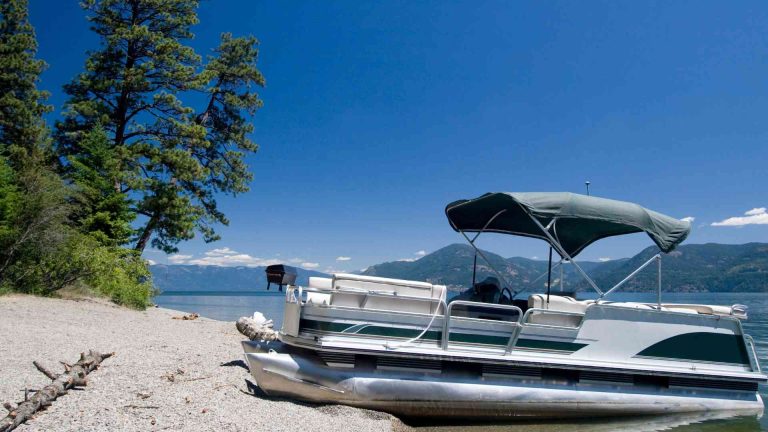
Benefits of Using a Bimini Top for Sun Protection on a Boat
Ah, the allure of the open waters, where the sun’s radiant embrace transforms each wave into a glistening dance. The joy of boating is a melody that resonates with adventure and serenity, a symphony composed by the soothing lull of the waves. Yet, amidst this aquatic reverie, a crucial note of caution beckons – the…

Lake Mead Boats for Sale: Setting Sail on Serenity
Lake Mead, a vast reservoir nestled between Nevada and Arizona, beckons boaters with its turquoise waters, stunning canyons, and endless opportunities for recreation. Whether you’re a seasoned captain or a first-time adventurer, finding the perfect boat to explore this aquatic wonderland is crucial. This comprehensive guide will equip you with the knowledge to navigate the…

Harnessing the Wind: Exploring Wind Turbines for Boats
For centuries, sailors have relied on the power of the wind to navigate the seas. Today, technology offers a modern twist on this tradition: wind turbines specifically designed for boats. These compact, self-contained units allow boaters to harness the wind’s energy to generate electricity, reducing reliance on fuel and generators, and contributing to a more…

(215) 508-2704
- Tao Catamarans
- Dolphin Catamarans
- Voyage Catamarans
- Omaya Yachts
- All Pre-Owned Catamarans
- Exclusive TMC Catamarans
- Sold Catamarans
- Buying A Multihull
- Selling A Multihull
- Sailing Schools
- Yacht Charters
- TMC Newsletter
- Employment Opportunities
- Mission Statement
- Affiliations
SAILDRIVES OR STRAIGHT SHAFTS? WHICH IS BEST FOR ME?
Story by Phillip Berman / June 20, 2017
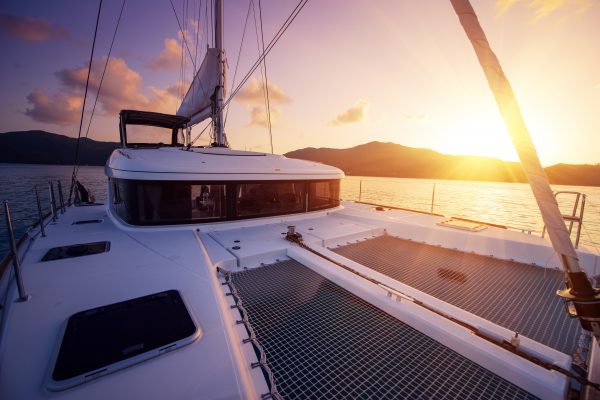
Many buyers who contact us these days develop some very strong personal preferences about a range of things: dagger boards versus keels, Yanmar versus Volvo, Flybridge versus Bulkhead Helms, etc. etc. Many buyers send us long “Must Have” lists.
One of the “Must Have’s” we are getting from some buyers these days is: “straight shaft engines.” Either there is a builder or two out there touting them because that is what they happen to offer, or some forum or blog or owner group stating their superiority, but we see a bit of an uptick in people who think straight shafts are the only way to go. What is clear to me is that most of these catamaran purchasers do not fully understand the advantages and disadvantages of straight shafts over sail drives or recognize how many limitations and negatives they pose for catamarans under 50 feet in length. Let me clear a few things up.
Straight Shaft Advantages
- Nobody currently makes sail drives for engines much larger than 75 horse power. As such, on most production cruising cats over 50 feet you will only be able to get straight shafts.
- Straight shafts are relatively mechanically simple. You have a shaft coming directly off the back of the engine that runs through a seal and then to a cutlass bearing and out into the water.
- Straight shafts are generally cheaper and easier to repair than sail drives.
- Straight shafts force the designer and builder to place the engines further forward in the boat and anytime you move weight toward the center you reduce pitching momentum. Many racing multihulls carry their engines in the very center of their hulls for this reason
Straight Shaft Disadvantages
- Straight shafts require precision engine alignment and tend to put much more pressure on engine mounts. Engines often need to be realigned.
- Straight shafts are always louder and produce more vibration than sail drives. In larger cats with long sterns and space the engines and shafts can remain aft of the sleeping quarters in separate sound insulated compartments. On smaller cats this is generally not the case.
- Straight shafts produce less effective horsepower at the prop because the prop is at an angle. On a typical 40 foot horse power engine you lose 3 to 4 horse power over a cat with sail drives.
- The less the prop is angled down the better the performance on a straight shaft. That usually means positioning the engines quite forward of the sterns. This in-turn produces the enormous negatives of having to house the engines under the aft bunks, or a portion of them, in most cats under 50 feet in length. This amounts to: louder inside the living spaces, more vibration, more heat, and a potential for engine exhaust to encroach on the yachts interior. It also makes it a bit more difficult to properly ventilate the engine rooms.
- Sleeping close to, or over the top of a running engine, especially a straight shaft, can be noisy and hot. Most shaft seals are supposedly “dripless,” but anyone who has spent time around them knows that when the dripless seal starts to drip you had better take care of it fast. I have seen plenty of flooded engine rooms in my years on straight shaft cats. Both seals and cutlass bearings are therefore best replaced every two to three years. Straight shafts, in short, are not maintenance free.
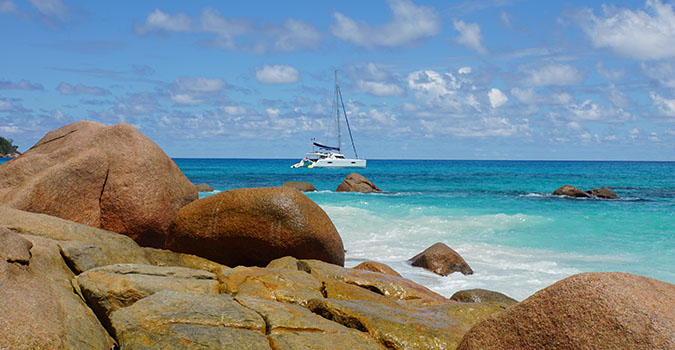
Sail Drive Advantages
- Sail drives are very quiet.
- Exact engine alignment is not critical.
- Sail drives can be positioned further aft in cats with ease and therefore make it possible to keep the engines out of the aft staterooms and in their own watertight engine rooms. On cats under 50 feet the design trend today is to produce sharper bows and wider, flared sterns aft, both to manage the engine weight aft and to get the cat to sit back on her haunches and pierce through waves to dampen pitching moment. A good example of this is the evolution of the Leopard 47 (a straight shaft boat) to the far superior sailing Morelli and Melvin designed Leopard 46 (a sail drive boat.)
- Sail drives offer more horsepower at the prop.
Sail Drive Negatives
- Sail drives generally cost more to replace than shafts. The typical drive leg for a 40 to 50 foot cat is between $3,500 and $5,000 dollars.
- Sail drives legs must always have good zinc protection or there is a danger of the shaft corroding. Sloppy zinc inspections can lead to the destruction of sail drive legs. I’ve seen plenty of this at surveys from sloppy owner care.
- Sail drives carry seals that are meant to prevent salt water incursion into the lubricated shaft leg. If the seals are compromised salt water can enter the drive leg and lead to internal corrosion. Note: water incursion in a drive leg is easily seen if one inspects the sail drive fluid level and finds milky looking oil. Most prudent sailors replace their sail drive seals at least every other haul out. If they see milky fluid they change the fluid right away and then replace the seals at the next haul out. (The newer drives allow you to change the oil from inside the engine room easily, without having to haul the boat.). When a sailor finds milky fluid on the older sail drive legs it is good to run the engines and transmissions frequently. This will keep the sail drive oil emulsified until the next haul when the seals can be replaced.
- Some older sail drives had cone clutch or shifting problems. These were sometimes found on Yanmar SD 50 drive legs. That problem has been overcome with the new generation drives.
I have heard some internet chatter that straight shafts are better if you run aground, but I strongly disagree. If you run aground hard with shafts or sail drives and for any reason they are not protected by a keel, or mini keels, or a skeg, you are going to have a bit of a mess on your hands either way. One of the reasons I much prefer engines in their own watertight engine rooms is that if one does run aground and water enters the engine room from a broken shaft or sail drive leg, the water remains in the engine room, never enters the living quarters where water damage leads to major floor and woodwork repair in general.
- Sleeping close to, or over the top of a running engine, especially a straight shaft, can be noisy and hot. Most shaft seals are supposedly "dripless," but anyone who has spent time around them knows that when the dripless seal starts to drip you had better take care of it fast. I have seen plenty of flooded engine rooms in my years on straight shaft cats. Both seals and cutlass bearings are therefore best replaced every two to three years. Straight shafts, in short, are not maintenance free.
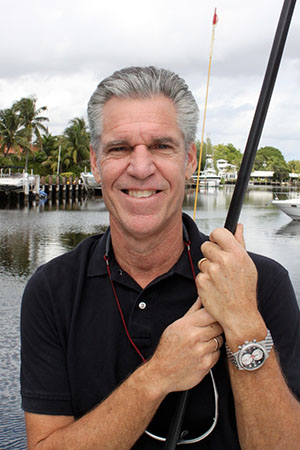
About Phillip Berman
- Are you a Spreadsheet Guy?
- Balance Catamarans is Born: A Bold Move in a Challenging Market
- Can a catamaran really sail upwind?
- Catamaran Depreciation
- Catamaran Vs Monohull
- Daggerboards vs. Keels
- Lessons Learned From A Free Spirit
- Placing a Boat Into Bare Boat Charter
- Post Survey Negotiations
- Saildrives or Straight Shafts? Which is Best For Me?
- Seller's Guide To Yacht Sales
- The 14 Biggest Mistakes When Purchasing a Used Catamaran and How to Avoid Them
- The 14 Biggest Mistakes When Purchasing a Used Cat…and How to Avoid Them Part Two
- The Perils of Internet Catamaran Shopping
- The Ten Commandments of Buying a Catamaran
Recent Posts
Join us at the 2024 annapolis sailboat show aboard the current marine 46.
- The Multihull Company Opens A New Office On Florida's Gulf Coast
Sailing the Tao 452
The multihull company announced as distributor for omaya yachts, the multihull company announces the sale of the first pre-owned balance 482.
- Introducing the Tao 452: On Display At The Annapolis Boat Show October 12 - 15, 2023
Join Us At The Annapolis Boat Show Aboard the Voyage 590
The multihull company announced as dealer for the voyage 590, 6 great starter catamarans.
- Ian Edmonson Joins TMC As Yacht Broker in Fort Pierce, FL.
Categories: Articles , Articles by Phil Berman , Catamaran Handling , Design and Construction , Engines and Mechanics
Recent News
The multihull company opens a new office on florida’s gulf coast.
The Multihull Company is pleased to announce that Josie Tucci has joined its team of expert yacht brokers in the Gulf Coast. Josie brings over 25 years of experience in the marine industry, with a strong focus on catamarans.Josie's career began in France with Dufour Yachts, where she honed her sales and marketing skills. She then transitioned to the US,...
Join Multihull Company Broker Captain Conor Dugan as he takes the helm aboard ‘Moxie’ in the azure waters of the Bahamas, to see how the Tao 452 performs under sail with a full cruising payload. https://youtu.be/V2scHvqn5vI?si=kuLwjFCYQdFj0_KW
The Multihull Company is thrilled to announce its appointment as the exclusive distributor for Omaya Yachts, an exciting new brand of Power Catamarans built with precision at the esteemed Elica Yard in Silastra, Bulgaria. This exciting new partnership further solidifies The Multihull Company's position as a premier distributor in the maritime industry, offering clients unparalleled access to cutting-edge vessels designed...
In early 2023, Cruising World approached us to seek our opinion on recommending a couple of brokerage catamaran options for first time catamaran buyers to consider when they first stepping into the catamaran market. Here are six boats hand-picked by The Multihull Company’s president and CEO, Capt. Will Miller, as excellent choices for brokerage-catamaran seekers. These are all worth a...
The Multihull Company Named Exclusive Dealer for Dolphin Catamarans and their New Model, the Dolphin 380
The Multihull Company, the world’s leader in multihull sales and service is excited to announce that it has been named the exclusive dealer for Dolphin Catamarans, a premier builder of high-quality catamarans, and their newest model, the Dolphin 380, designed by Philippe Pouvreau. "We are thrilled to be working with Dolphin Catamarans again and to be able to offer their...
The Multihull Company is thrilled to participate in the 2024 Annapolis Sailboat Show, held from October 10 – 14, 2024 in downtown Annapolis, Maryland. The Annapolis Boat Show is a highly anticipated annual event that brings together boating enthusiasts, industry professionals, and maritime aficionados from around the world. Visitors to the Annapolis Sailboat Show can look forward to an exclusive...
The Multihull Company is pleased to announce the closing on the Balance 482 "SeaLife" We wanted to take a moment and thank her new owners on their amazing new catamaran, and to also congratulate our team handling the sale. TMC agent Andrew Hodgdon successfully represented the buyers on the sale of the vessel, while TMC CEO Will Miller represented the...
Introducing the Tao 452: On Display At The Annapolis Boat Show October 12 – 15, 2023
The Multihull Company is thrilled to unveil the new Tao 452, an exciting addition to the world of blue-water performance cruising catamarans. Meticulously engineered and crafted to perfection, the Tao 452 is set to redefine the catamaran experience for sailors worldwide. If you've ever felt the need for more sailing performance from your current production charter catamaran or been disappointed...
The Multihull Company is excited to announce its participation in this year's Annapolis Sailboat Show. The event will be held from October 12 - 15, 2023 in downtown Annapolis, and The Multihull Company will be showcasing the exquisite Voyage 590 catamaran from Voyage Yachts. The Annapolis Boat Show is a highly anticipated annual event that brings together boating enthusiasts, industry...
The Multihull Company is pleased to announce their appointment as a dealer for Voyage Yachts and their new model – the Voyage 590! The Voyage 590 is being celebrated as the ultimate, luxury sailing catamaran with all the comforts of home surrounded by panoramic views of paradise. She maximizes luxury accommodation and comfort, with the performance and blue-water capability characteristic...
- Read All Articles
We take pride in our happy customers
Andrew, and Andrew are both fantastic. Transaction was smooth and professional highly recommend the team over at Multihull.
— Paul Fosler
I just purchased my first large boat (my dreamboat) and Michael Streng and the rest of TMC was amazing! I really felt like I was a VIP customer because they were fast and easy to communicate with and worked ahead of me. It really was a treat and I would use them again any day!
— Collin Simmons
Andrew Hodgdon and The Multihull Company have done an extraordinary job facilitating the sale of our catamaran. There were a couple of challenges (geography and timing) that made this sale a little tricky, but, as usual, Andrew was amazing. I’ve been buying and selling cruising boats for over 12 years and Andrew is, without a doubt, the best broker I’ve worked with.
— Mort Orlov
Andrew Hodgdon at TMC-St. Augustine kept us thoroughly informed during the sale of our boat and took the extra steps necessary to complete the deal. His knowledge of the process made a complex deal very easy. Needless to say, we are extremely happy and satisfied with the job that Andrew did.
— David Baxter
A shout out to Andrew Holland at the TMC main office, who handled the closing transaction of the sale of our boat. Very professional and thorough. Thank you!!
Trust & Expertise About Us
Successful relationships cannot exist without it. At The Multihull Company we base every relationship on a firm commitment to earning and retaining our client’s trust.
Advice of any kind is valuable only when grounded in hard-won expertise. It too, must be trustworthy. Trust and expertise define the heart and soul of The Multihull Company. We are a team of skilled professionals who thrive on providing expert, trustworthy advice and service to catamaran and trimaran sailors around the globe.
Follow us @themultihullcompany
- Pre-Owned Sales
Global Locations
New England +1-267-324-9067
Philadelphia +1-215-508-2704
Virginia +1-757-407-2526
Annapolis +1-703-350-8160
Charleston +1-843-364-4123
Brunswick +1-937-243-2213
Saint Augustine +1-910-477-2508
Fort Pierce +1 (772) 295-7900
West Palm Beach +1-561-312-0010
Ft. Lauderdale +1-215-508-2704
Miami +1-513-677-5338
St. Petersburg +1 727-432-2739
Seattle-Tacoma +1-206-297-1151
St. Martin +590 690 58 66 06
Grenada +1-473-457-3245
Puerto Rico +1-787-379-7348
Panama +1-305-735-1661
Trinidad +1-868-680-8909
Croatia +385 95 849 8009
France +33 (0) 6 73 97 17 30
Australia +61 (0)7 5444 4822
© Copyright 2024 The Multihull Company. All rights reserved.
Did You Know That We Offer Contract to Closing Services? Click Here to Find Out More.
Need Marine Financing? Apply Here With Our Partner, First Approval Source
- Catamaran Interviews
- Catamaran Reviews
- Buying Advice
- Selling Advice
- Woods Design Advice
- Admiral 38
- Admiral 40
- Admiral 50
- Americat 3014
- Antares 44
- Aquila 44
- Aquila 48 Power Catamaran
- Aventura 37
- Balance 442
- Balance 482
- Balance 526
- Bali 4.0
- Bali 4.1
- Bali 4.2
- Bali 4.3
- Bali 4.4
- Bali 4.5
- Bali 4.6
- Bali 4.8
- Bali 40 Catspace
- Bali 5.4
- Bali Catsmart
- Beneteau Blue II
- Broadblue 346
- Broadblue 38 Prestige
- Broadblue 385
- Broadblue 435
- Broadblue 46
- Rapier 400
- Rapier 550
- Catalac 10M
- Catalac 11M
- Catalac 12M
- Catalac 8M
- Catalac 900
- Catalac 9M
- Catana 381
- Catana 39
- Catana 401
- Catana 40S
- Catana 411
- Catana 42
- Catana 42 S
- Catana 431
- Catana 44
- Catana 471
- Catana 50
- Catana 521
- Catana 531
- Catana 55
- Catana 581
- Catana 65
- Catathai 44
- Chris White
- Chris White 48 Voyager
- Chris White 55
- Condor 40
- Contour 34
- Corsair F28 R
- De Villiers
- Dean 365
- Dean 400
- Dean 440
- Dean 500
- Dix DH550
- Dolphin 380
- Dolphin 460
- Edel 35
- Endeavour 30
- Endeavour 35 Victory
- Endeavour 36
- Endeavour 44
- Endeavour 44 TrawlerCat
- Endeavour 50 Pilothouse Trawler
- Excess 11
- Excess 15
- F-41
- Fastback 43
- Fastcat 445
- Fisher 28
- Fisher 32
- Fortuna 36 Island Spirit
- Fortuna 401 Island Spirit
- Fountaine Pajot
- FP 32 Maldives
- FP 35 Tobago
- FP 36 Mahe
- FP 37 Antigua
- FP 38 Athena
- FP 39 Fidji
- FP 40 Isla
- FP 40 Lavezzi
- FP 40 Lucia
- FP 40 MY
- FP 40 Summerland MY
- FP 41 Lipari
- FP 42 Astrea
- FP 42 Venezia
- FP 43 Belize
- FP 44 Helia
- FP 44 Orana
- FP 45 Elba
- FP 46 Bahia
- FP 46 Casamance
- FP 48 Salina
- FP 50 Saba
- FP 56 Marquises
- FP 57 Sanya
- FP 58 Ipanema
- FP 60 Eleuthera
- FP Saona 47
- Fusion 40
- Gemini 105
- Gemini 3000
- Gemini 3200
- Gemini 3400
- Gemini Freestyle 37
- Gemini Freestyle 399 Power
- Gemini Legacy 35
- Grainger 420 Mystery Cove
- Gunboat 55
- Hirondelle 7M
- HopYacht 30
- Island Packet
- Island Packet Cat 35
- Kennex 420
- Knysna 440
- Knysna 480
- Knysna 500
- Knysna 550
- Lagoon 35
- Lagoon 37 TPI
- Lagoon 380
- Lagoon 39
- Lagoon 40
- Lagoon 400
- Lagoon 410
- Lagoon 42
- Lagoon 42 TPI
- Lagoon 420
- Lagoon 421
- Lagoon 43 PC
- Lagoon 44 Power Cat
- Lagoon 440
- Lagoon 450
- Lagoon 46
- Lagoon 470
- Lagoon 50
- Lagoon 500
- Lagoon 52F
- Lagoon 55
- Lagoon 560
- Lagoon 570
- Lagoon 620
- Lagoon Seventy 8
- Lagoon Sixty 7
- Leeuwin 42
- Leopard 38
- Leopard 39
- Leopard 39 PowerCat
- Leopard 40
- Leopard 42
- Leopard 43
- Leopard 44
- Leopard 45
- Leopard 45 Classic
- Leopard 46
- Leopard 46 Lion PowerCat
- Leopard 47
- Leopard 47 PowerCat
- Leopard 48
- Leopard 50
- Leopard 51 PowerCat
- Leopard 53 PowerCat
- Leopard 58
- Lidgard 73 Executive
- Looping 50
- Maine Cat 30
- Maine Cat 38
- Maine Cat 41
- Manta 40
- Manta 42
- Matrix 450 Vision
- Matrix 760 Silhouette
- Maverick 400
- Maverick 420
- Maverick 440
- Moxie 61
- Nautitech 40
- Nautitech 40 Open
- Nautitech 44 Open
- Nautitech 442
- Nautitech 46 Open
- Nautitech 47
- Nautitech 47 Power
- Nautitech 475
- Nautitech 65
- Neel 45
- Neel 47
- Outremer 40
- Outremer 45
- Outremer 50 Standard
- Outremer 55
- Outremer 5X
- PDQ 32
- PDQ 36
- PDQ 42 Antares
- Privilege 37
- Privilege 39
- Privilege 42
- Privilege 43
- Privilege 435
- Privilege 45
- Privilege 465
- Privilege 48 Transcat
- Privilege 482
- Privilege 495
- Privilege 510
- Privilege 65
- Privilege Serie 5
- Prout 31 Quest
- Prout 33 Quest
- Prout 34 Event
- Prout 35 Snowgoose
- Prout 37 Snowgoose
- Prout 37 Snowgoose Elite
- Prout 38
- Prout 38 Manta
- Prout 39 Escale
- Prout 45
- Prout 46
- Royal Cape 45
- Royal Cape 500 Majestic
- Royal Cape 530 Majestic
- Sailcraft 30 Iroquois
- Sailcraft 32 Comanche
- Sailcraft 35 Cherokee
- Sailcraft 41 Apache
- Sailcraft 44 Apache
- Scape 39
- Wildcat 350
- Seacart 30
- Seawind 1000
- Seawind 1160
- Seawind 1190
- Seawind 1200
- Seawind 1260
- Seawind 1600
- Simpson 48
- Solaris 36 Sunrise
- Solaris 36 Sunstar
- Solaris 42
- St Francis 44
- St Francis 48
- St Francis 50
- Stealth 11.8
- Sunreef 60
- Sunreef 62
- Sunreef 70
- Sunreef 74C
- Sunreef 82 DD
- Sunreef 88 DD
- Switch 51
- Switch 55
- TRT 1200
- Heavenly Twins 26
- Ocean Twins 38
- Vaan R5
- Vision 444
- Voyage 380 Maxim
- Voyage 400 Norseman
- Voyage 430 Norseman
- Voyage 440
- Voyage 450 Cabriolet
- Voyage 47 Mayotte
- Voyage 480
- Voyage 500
- Voyage 580
- Voyage 590
- Kronos 45
- Wharram 38 Tiki
- AMI 320 Renaissance
- Woods 22 Wizard
- Woods 35 Banshee
- Woods 35 Flica
- Woods 36 Scylla
- Woods 36 Vardo
- Woods 38 Transit
- Woods 40 Meander
- Xquisite X5
- Xquisite X5+
Catamaran Drives Types – Outboards, Inboards and Drive Shaft Configurations
- Post author By Patrick Davin
- Post date September 23, 2020
- 1 Comment on Catamaran Drives Types – Outboards, Inboards and Drive Shaft Configurations

Catamarans these days have many options for their engine based propulsion, even more than monohulls due to the more diverse configurations of a catamaran. The traditional twin diesel engines is a popular arrangement, and dual or single outboard configurations are also becoming popular. When choosing an inboard engine, you then often have a decision to make in drive shaft configuration: traditional straight shaft, or a saildrive.
The drive type has long lasting consequences for how you use and maintain a boat, so it’s an important factor. It affects how much power you have for motoring into strong winds or against current, fuel economy, reliability, maintenance needs, and purchase plus maintenance costs. And let’s not forget noise level and liveability – the choice between diesel inboards vs gas outboards can have a big impact on cabin storage areas and engine noise level.
Single Gas Outboard

Outboards have always been common in smaller sailing boats (under about 30 feet) that don’t require a great deal of power to get them moving. However they’re now becoming popular with larger catamarans as well, up to about 40 or 45 feet. They offer several unique advantages over inboard diesel engines. First and foremost, they’re significantly less expensive than a diesel engine – a 30hp outboard might be around $4,000 while a 30hp diesel could easily be $20,000. They’re also smaller and lighter, and take up less space inside the hull – freeing up storage or accommodation space.
Smaller catamarans or lightweight ones can often get by with a single outboard. The advantages are in the weight and cost savings of only having one engine instead of two, and only one engine to maintain. The downside is it may make maneuvering in a marina a bit trickier, and there’s no backup engine if the one outboard has an issue.
Twin Gas Outboards

Catamarans have a unique advantage over monohulls in that they can have more than one engine. Two engines provide many advantages – redundancy in case one fails at sea and greater maneuverability in marinas. Many catamarans can motor reasonably fast on only one engine – which some owners do to save fuel and reduce engine hours – but two are nice to have for the redundancy and for pivoting easily in tight quarters.
Twin outboards are usually mounted at the aft end of each hull, or in drop-down lockers built into the cockpit. Some catamarans with twin outboards have them located in lockers under the cockpit seats (ex, Seawind 1160 lite and PDQ 36) which is handy because they can be raised to eliminate drag yet are easily accessible to work on, and don’t add an unsightly appendage to the stern.
Speaking with an owner of a Seawind 1160 lite catamaran with dual outboards located in a well under the cockpit seats, he noted appreciating all the space they freed up vs having inboard diesels installed at the aft of each hull. In the space normally occupied by diesel engines, they store two bikes, a kayak, a water heater and other gear.
He also loves that they’re quiet, fuel efficient, emissions efficient, and can be raised with electric tilt for zero drag in the water while sailing. One disadvantage he noted is the impellers are harder to replace, and he’s hauling out to make it easier to replace the gear oil along with impellers.
Outboards may not have as long a life span as diesels, but when it comes time to replace, he can do so relatively easily anywhere in the world, with much less work than replacing a diesel. One possible disadvantage is in rough seas or steep swell, outboard props may come out of the water – whether this can happen will depend on the design and size of the catamaran.
Single Diesel Inboard/Outboard Sillette Drive

A somewhat unique option is the Sillette Sonic drive (common on Gemini 105 catamarans) which is a type of saildrive. It allows using an inboard engine with an outboard drive leg exterior to the boat. The drive leg can be raised while under sail, providing the same no drag advantage as outboards, while having the engine inboard which protects it from saltwater. The drive leg is typically mounted from the bridgedeck or in a pod underneath.
Diesel Inboards with Direct Drives

Inboard diesel engines have historically been the most common option in mid to large size monohulls and multihulls. Diesels excel in delivering high working power while being exceptionally reliable over a long service life. Since a diesel is located inside the boat, it’s exposed to a lot less seawater than outboards are. Diesels can also support a powerful alternator to charge the house batteries, reducing the need for alternate power generation such as solar, wind or a generator.
The straight shaft is the more traditional option and is a tried and tested design from work boats to pleasure boats. In this design the propellor shaft connects from the engine (via a shaft coupling), passes through the hull of the boat (via a shaft seal) and connects to the propellor. Typically there will also be a strut forward of the propellor to stabilize the spinning prop shaft.
The advantages of this design are that it’s robust and easy to maintain. If your propellor strikes a submerged object, it may get damaged but isn’t likely to rip a huge hole in the boat. The main disadvantage in a catamaran is the shaft placement limits where the engine can be placed – it must be fairly far forward, and takes up more space due to the shaft and transmission arrangement. Additionally, since the shaft isn’t perfectly horizontal, the propellor works at a slightly lower efficiency.
Diesel Inboards with Saildrives

Diesel inboards paired with a saildrive are quickly becoming the most common installation option on newly built catamarans. With a saildrive there’s no shaft or strut needed, just a drive leg attached to the hull of the boat underneath the engine. A couple advantage of saildrives is that they’re easier for manufacturers to install, and allow more flexible positioning of the engine to free up greater interior space. Saildrives can also have higher efficiency due to the vertical orientation of the propellor. Saildrives often run quieter, with less vibration than a conventional straight shaft system.
There are a few possible disadvantages that boaters typically cite, relating to maintenance: watertightness of the saildrive seal, maintenance of the drive leg oil, and corrosion. The saildrive seal must be maintained or the boat could potentially flood. The drive legs also have gear oil which usually requires hauling out to replace (except for some newer saildrives which support changing it from inside the boat). Neglecting the maintenance could cause seawater to start mixing with the oil. Lastly, corrosion is a concern because the drive leg contains metal components which must be protected with sacrificial anodes.
Gasoline Inboards
Gasoline inboards, such as the Universal Atomic 4, are sometimes found on sailboats but are becoming much less common. A gas engine has greater risk of fire or explosion due to fuel vapor build-up. Fuel efficiency can also be slightly lower than a diesel engine, and engine longevity may be less than with diesel engines.
Electric Drive Type

Electric propulsion options are still a niche market in boating but are becoming increasingly popular as battery technologies advance. Electric systems can be other hybrid (electric recharging is assisted by a generator) or full electric (recharging only via solar and other non-fuel sources). Hydro generation can be a good recharging source on catamarans since their higher sailing speeds improve the output of hydro generators.
The advantages of an electric drive are: environmentally friendly, very quiet when operating, frees up space that a large engine and fuel tanks consumed, and relatively easy maintenance compared to diesel or gas engines. The main disadvantage of electric drives is the motoring range may be more limited, especially in the full electric option.
It’s great to have so many options in today’s catamaran designs. Having these choices allows you to prioritize what’s most important in your sailing and maintenance plans and adopt innovative technologies that make your boat best suited to your needs.
You can’t go wrong with the traditional choice of diesel inboards, but in mid-size lightweight catamarans you may also want to consider outboards for the space they can free up, lower initial cost, and quiet, drag-free sailing.
- Tags Buying Advice

By Patrick Davin
Patrick is a full-time cruiser in the Pacific Northwest, sailing the waters from Seattle to Alaska.
1 reply on “Catamaran Drives Types – Outboards, Inboards and Drive Shaft Configurations”
I am looking for a silkette sonic mark 2 out drive in working order…1994 or newer…can you help?
Leave a Reply Cancel reply
Your email address will not be published. Required fields are marked *
Save my name, email, and website in this browser for the next time I comment.
ACTIVE STORM TRACKER Hurricane and Tropical Storm Information Learn more

Service Locator
- Angler Endorsement
- Boat Towing Coverage
- Mechanical Breakdown
- Insurance Requirements in Mexico
- Agreed Hull Value
- Actual Cash Value
- Liability Only
- Insurance Payment Options
- Claims Information
- Towing Service Agreement
- Membership Plans
- Boat Show Tickets
- BoatUS Boats For Sale
- Membership Payment Options
- Consumer Affairs
- Boat Documentation Requirements
- Installation Instructions
- Shipping & Handling Information
- Contact Boat Lettering
- End User Agreement
- Frequently Asked Questions
- Vessel Documentation
- BoatUS Foundation
- Government Affairs
- Powercruisers
- Buying & Selling Advice
- Maintenance
- Tow Vehicles
- Make & Create
- Makeovers & Refitting
- Accessories
- Electronics
- Skills, Tips, Tools
- Spring Preparation
- Winterization
- Boaters’ Rights
- Environment & Clean Water
- Boat Safety
- Navigational Hazards
- Personal Safety
- Batteries & Onboard Power
- Motors, Engines, Propulsion
- Books & Movies
- Cockpit Confessions
- Communication & Etiquette
- Contests & Sweepstakes
- Colleges & Tech Schools
- Food, Drink, Entertainment
- New To Boating
- Travel & Destinations
- Watersports
- Anchors & Anchoring
- Boat Handling
- ← Seamanship
Sail And Power Catamarans: Developing A 'Catitude'
Advertisement
Once you get the hang of it, multihulls are a blast to drive. Here's how to handle these versatile, comfortable boats — sail or power — for those considering chartering a cat.
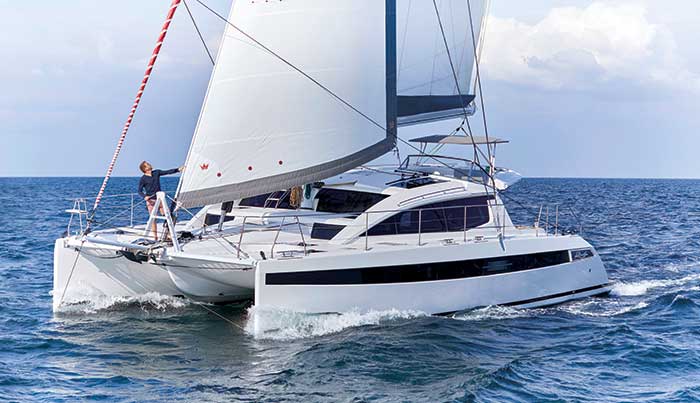
This 43-foot cat is trimmed well for upwind sailing. But once main and boom are eased out to accommodate wind direction, the jib may create a pinched slot as jib tracks are located on cabin tops. (Photo: Privilège Catamarans/Nico Krauss)
As a freelance marine journalist with a U.S. Coast Guard 100-Ton Master license, I get to captain dozens of boats of various designs and sizes. I'm also a cat convert from monohull boating with plenty of firsthand knowledge to share. If you're thinking of chartering or buying a cat, you'll benefit from their inherent advantages. Cats offer more room than the same-lengthmonohulls, they usually have better system access, and sailing cats may be faster in light wind because they're not dragging a heavy keel through the water.
Cats operate upright so you won't be on your ear in a blow. You can cook and sleep on a passage without "walking on the hull" like in a monohull that's heeling. You also spend more time above the waterline on a cat rather than the dreaded "down below" on a monohull.
Of course, for all the pluses, there are minuses: Finding a marina berth for a cat is difficult and expensive. Unlike monohulls that get into the groove and slice through waves when sailing upwind, cats can slap the water if the bridge deck clearance is low, or when the seas meet the underside of the bridge deck.
People who usually sail monohulls may be accustomed to being alerted to the wind rising too much by the increasing heel of the boat. If you get this amount of heeling in a cat, you may be beyond the point of no return; though this isn't as likely with many of today's heavier, wider models. Cats are not self-righting; you have to stay alert to worsening weather.
Also, unless it's a performance model with daggerboards, a cat only has mini-keels, so it won't point high and can be a bit like maneuvering a shoebox. They don't track well, tending to slip to leeward, and they tack slowly because they have to push two hulls rather than one through the eye of the wind. Finally, cats have fairly shallow rudders, so close-quarters maneuvering comes more from dual engine thrust, rather than the water flowing over the rudders — effective, but something to get used to.
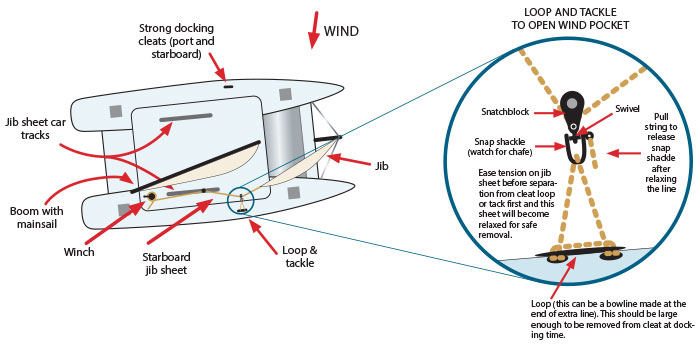
An easy adjustment to position the jib out farther and improve performance is shown in this illustration.
When it comes to the emerging power-catamaran trend, driving cats under power is a straight-up joy. Their two props are set wide apart resulting in much better control and precise maneuvering in close quarters. Cats don't coast like monohulls because they don't have a keel to keep them tracking, so gliding into a dock at a shallow angle doesn't work, and neither does using propwalk to tuck in the stern. You use the engines to spin a cat in its own length or walk it sideways, both of which are easier to master than the nuances of driving a monohull.
Regardless of whether you're docking, picking up a mooring, or anchoring, always keep the boat powered up and ready to drive until you're done because you can't just push a 45-foot cat around by hand. Here are some handling tips that apply to handling both sail and power catamarans.
Don't Ding The Dock
When there's no wind, bigger sailcats also have an engine, which is needed in each hull. They aren't powered to drive as fast, but the principles are the same. Keep in mind, boats and conditions are varied, so we can only give examples here.
- Forget about the wheel when docking side-to or forward. Lock it on the centerline with the wheel lock or by leaning your body against it and maneuver using the throttles (see illustrations below). Power forward with the starboard engine, and aft with the port, and the cat moves to port and vice versa. Turn this around in your head when in reverse. Fine tune adjustments by using one engine at a time. Pause the propeller in neutral when changing directions from forward to reverse and vice-versa to give transmissions time to engage.
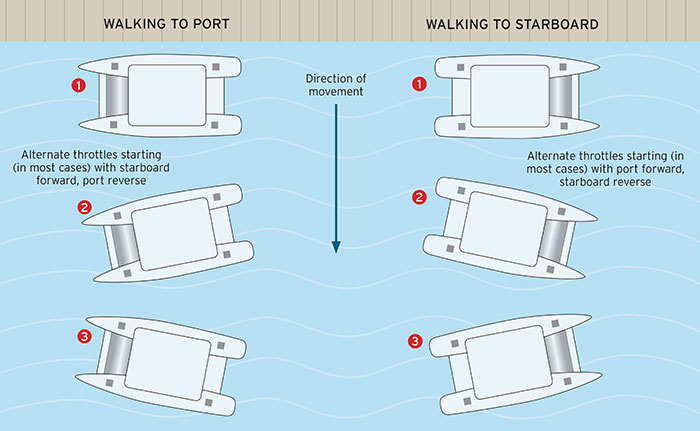
- Backing into a slip: Cats dock stern-to because the bows are high and it's easier to step on and off the dock via the swim platforms aft. When backing straight into a slip, come abeam, pivot 90 degrees with the engines until centered, and back in. If Med-mooring, drop anchor and pay out the rode slowly as you back with both engines. Set the anchor part way back, then keep backing and letting out rode until you're close enough to the dock to tie up the stern lines. Have fenders already tied aft to cushion the transoms. Tighten up on the anchor rode with the windlass.
Wind And Current
As with any boat, it's best to work against the current for better control.
- When departing a starboard tie-up with the current coming at the bow, put a fender and line on the starboard aft corner, power aft with the port engine, pivot, then drive out forward with both engines against the current. If the current is coming from behind, back out, putting a line and fender on the starboard bow. Power in reverse with the starboard engine, pivot, and then back out with both engines.
- Cats have high cabin tops, producing lots of windage. In tight quarters, you may need to turn more sharply when approaching a dock or line up to windward before backing in.
Picking Up A Mooring
Cats have high hulls and it's easy for the skipper to lose sight of a mooring ball before the boat is close enough for the crew to pick it up. Keep the mooring on the side where you can best see forward so you can keep an eye on the ball at all times. (Some cat helm stations are offset to one side or the other.)
- Hand signals or a headset for you and the crew make communications easier to send and receive rather than yelling.
- Have your crew pick up the mooring with a boat hook while you maneuver with the engines to keep station — easier on a cat than a monohulls, even in wind and current.
- Have lines ready by stringing one off a cleat on each hull. To do this, thread each line through the eye or loop, then back onto its cleat. Do this with both sides and adjust until the mooring sits on the centerline. This will minimize swinging and chafe, and noise in the forward cabins.
Anchoring is generally easier on a cat than a monohull. There's more room forward for crew to work, and you can keep the boat steady with the engines.
- A bridle should be preset with a line from each hull (under the trampoline) and hook or shackle in the middle. Once the anchor and chain is down, attach the bridle to the chain (usually done near the windlass) and set the hook putting the pressure on the bridle. Once set, let out enough chain to create a catenary.
- When raising anchor, take care to keep the chain in between the bows or you risk damaging the fiberglass by shaving the bottom of one or the other if you overrun the chain or lose track of where it is. Crew communication is critical.
Sail-Specific Cats
Here's how to coax the best out of a sailing catamaran:
- Big cats carry huge mainsails, so raising one typically requires an electric winch. It also may be challenging to keep full battens out of the lazyjacks that hold up the sail bag, so it can take a few people to raise a large sail. Also, there are usually multiple angles to the way halyards are run on cats with flybridges, resulting in friction. So "dropping" the mainsail can be more like "pulling" it down. Attach a messenger-type line to the mainsail head so it comes down easier.
- Reefing can be a guessing game because you don't feel a cat being overpowered like you do a monohull. Depending on the direction of sail and the sea state, you may be able to reef a little later with the wind a few knots higher — an individual call.
- Cat headsail tracks are typically on the cabin top making the sail curve back on itself, creating a wind break when it's sheeted in. A trick is to bring a spare line from the jib clue out to a cleat on the side deck to open up the slot to let air flow through. Check for chafe on the cabin and don't forget to release it before tacking.
- The majority of multihulls are built to sail on a beam or broad reach, and that's where they're the happiest. Dead downwind, cats shimmy a little making wing-on-wing sailing tricky, not all that different from monohulls. For more comfort, choose one broad reach or the other, then jibe when necessary.
- Cats with daggerboards can point higher and track better because, like monohulls, they have an appendage (or two) down low in the water for a better center of lateral resistance. Daggerboards are mostly used when sailing upwind, and it helps to keep the leeward board lower than the windward one. Sailing downwind with the boards lowered could create a tripping hazard, especially in rough seas where it's possible to stuff the bows into the wave ahead. When motorsailing, a trick to saving fuel and pointing higher is to run only the leeward engine for a little pointing assist.
Next time you have an opportunity to test drive a power or sailing cat, or to charter one on your next holiday, try it! The learning curve is so quick, it's really fun, and before you know it, you, too, may convert to being a cat person!
Catamaran Brands
You can further explore the array of catamarans, big and small, power and sail, by visiting any of these leading manufacturers.
- Aquila Power Catamarans
- Aspen Power Catamarans
- Fountaine-Pajot
- Horizon Power Catamarans
- Leopard Catamarans
- Nautitech 47 Power
- Balance Catamarans
- Fountaine Pajot
- Outremer Catamarans
- Seawind Catamarans
Related Articles
The truth about ceramic coatings for boats.
Our editor investigates the marketing claims of consumer-grade ceramic coatings.
Fine-Tune Your Side Scan Fishfinder
Take your side-scanning fishfinder off auto mode, and you’ll be spotting your prey from afar in no time
DIY Boat Foam Decking
Closed-cell foam flooring helps make boating more comfortable. Here’s how to install it on your vessel
Click to explore related articles
Zuzana Prochazka
Contributor, BoatUS Magazine
Zuzana Prochazka is a freelance journalist specializing in writing, editing, and photography in boating and travel publications. She writes for a dozen boating magazines and websites and a growing list of travel publications. She enjoys combining her passions, which include seeing the world, sailing the oceans, and sharing her experiences through the written word. She holds a U.S. Coast Guard 100 Master license.
BoatUS Magazine Is A Benefit Of BoatUS Membership
Membership Benefits Include:
Subscription to the print version of BoatUS Magazine
4% back on purchases from West Marine stores or online at WestMarine.com
Discounts on fuel, transient slips, repairs and more at over 1,200 businesses
Deals on cruises, charters, car rentals, hotel stays and more…
All for only $25/year!
We use cookies to enhance your visit to our website and to improve your experience. By continuing to use our website, you’re agreeing to our cookie policy.
|
|
Sail Drives
Saildrives are often used on catamarans as they result in a very compact drive system. Multihulls have narrow hulls, so there's not enough room to walk around an engine, as there is on most monohulls. So a catamaran's engines are usually under the aft bunks, which usually doesn't leave much room for a gearbox, propeller shaft, external "A" bracket, and still have room for the rudder. Saildrives attach to the back of the engine and immediately go down through the bottom of the boat, sort of like the leg of an outboard motor. A pair of flexible seals (the main seal and a backup) keep water from flooding the engine room on Yanmar saildrives (Volvo saildrives only have a single seal). There are a handful of manufacturers who offer saildrives, but Volvo and Yanmar are probably the biggest, and the vast majority of saildrives we see are produced by those two manufacturers. Since we have Yanmar 4JH2CE engines and SD31 saildrives, the comments below are aimed primarily at Yanmar saildrives, but Volvo saildrives are similar enough that many of the comments apply to both.
The first 6 subjects we discuss are modifications we recommend folks do to their saildrives. The last 3 are procedures we've had to do recently and we thought we'd share our experiences, to help others. Subjects in this article include:
| - - - - - - - - - - | How to make sure water doesn't get into your oil. | |
| - - - - - - - - - - | A cheap and easy way to help preserve your secondary seal. | |
| - - - - - - - - | To prevent plastic bags from being sucked up the water inlets | |
| - | What was Yanmar thinking to use a multi‑turn valve here?!? | |
| - - - - | This is not difficult to do, and will allow you to use the same paint on the whole of the bottom of your boat. | |
| - - - - - - - - - - - - | Make your own instead of buying the flimsy official parts. | |
| - - - - - - - - - | Several tips on removing the leg, as well as how to replace the leg without pinching the O‑ring | |
| - - - - - | When that seal starts leaking, this is what you have to do | |
| - - - | This is surprisingly easy to do! |
| Saildrive gear-cluster removed so we can replace the seals |
Oil Header Tanks Like virtually all manual gearboxes, saildrives are filled with 90W hypoid oil (ideally, salt-resistant oil if you can find it). This oil is held in by a pair of oil seals around the propeller shaft. Those oil seals will eventually wear out so they need to be replaced periodically. They're usually fairly standard seals, but replacing them means dismantling the bottom end of your saildrive and then disassembling the gear-cluster to get at the seals - a messy and fiddly business requiring some familiarity with the parts and procedures involved (and sometimes requiring special tools).
But it's very important to service those seals before they leak. Since the saildrive is wholly below water level, the seawater on the outside is at a slightly higher pressure than the oil on the inside. This means that if the seals start to leak, seawater will enter the bottom of the saildrive and start turning your oil into mayonnaise. If this happens, you need to haul the boat out of the water and service the saildrive as soon as possible , before the seawater starts to corrode the gears and bearings.
| Oil tank & bracket in our port engine room |
In the Seychelles we ran into an excellent father/son machine shop, and I got to talking with the father. He'd seen a lot of marine equipment - in fact, he was refurbishing a turbocharger for a 5,000 horsepower diesel engine when I met him. When I explained this problem with the oil seals, he had an excellent idea: Put an oil header-tank as high up in the engine room as practicable, and run a hose from it to the saildrive . That way, the oil will be at a slightly higher pressure than the seawater. If the seals start to leak before their normal maintenance interval, all that will happen is that a bit of oil will leak out. You'll be able to see the oil level dropping slightly in the header tank, and that will tell you that you need to replace the oil seals the next time you haul the boat. But it's no longer an emergency!
We did this conversion in 2009 when we were in South Africa, and it has worked very well. The oil-fill / dipstick hole is a standard 1" (pipe?) thread, so we just removed the dipstick and replaced it with some pipe fittings to take the hose to the header tank. Using a plastic reducer where it goes into the saildrive will insure that you have no thread incompatibilities. Our SD31 required that the pipe extend above the body of the SD before putting in the elbow. We put a small valve in the hose so we can shut the header-tank oil off when we want to change the saildrive oil, so we don't change the oil in the header.
There are a couple of caveats here. First, the normal filler/dipstick keeps the pressure in when the oil heats up and expands. This strikes us as crazy, as it can force the oil past the propshaft seals. We can see no advantage to letting the pressure increase like that, and this header tank arrangement will keep the oil pressure much more constant, and at a lower pressure than a hot normal dive. This should be especially good for the oil seal on the input shaft from the engine.
| Oil piping into the saildrive - plastic & stainless steel |
Another issue is that the prop‑shaft oil seals should be turned around. Oil seals are direction sensitive. The flat side should go against what you don't care as much about, while the side with the spring (to hold the seal against the shaft) should go towards the side of the stuff you don't want to go past the seal. Changing the seals around is easy to do once you have the lower gear‑cluster apart. Some people we've talked to have put the 2 seals back to back, with the inner seal set to keep the oil in, and the outer seal set to keep the water out. We take this a step further. In our opinion, keeping the water out is the most important, so we put both seals with their backs towards the gears. If you do this, remember to remove the spring from any seals that will face the saltwater and replace them with an O‑ring that won't rust, especially if you use generic (non‑Yanmar) seals.
Finally, it will probably take a little while (several days of motoring) before all the air works its way out of the saildrive and up the hose, through the thick oil to the header tank. While this is happening, it may look like you're losing some oil, but it's just air coming out. Top it up, and it should stop eventually.
Secondary Seals Yanmar saildrives have 2 flexible seals between the saildrive leg and the hull, to keep the water out. The primary seal is a monster of thick rubber while the secondary seal, above the primary seal, is much thinner, more like a car inner‑tube. The secondary seal is what you actually see from above, and it's really only there for emergencies, in case something happens to the primary seal. But for the secondary seal to be effective, it has to be able to survive whatever caused the primary seal to fail. It's unlikely that the primary seals will simply "wear out" and develop a leak. Our seals have been in for 15 years, 4,000 hours of motoring, and they look brand new. It's going to be an accident that causes that main seal to leak.
| Hose clamp around our secondary saildrive seal |
In the Ha'apai Group of Tonga we had a big problem when we caught a rope in our starboard propeller and ripped that engine and saildrive clean off its mounts. This ripped the main seal that joins the saildrive to the hull, so we had water coming into the engine room. We were very lucky that the secondary seal had just popped off, and could be reset fairly easily. In fact, once we reset the secondary seal, it didn't even affect our cruising much, as we just continued cruising with our port engine (although anchoring was distressingly awkward).
It turns out that SunSail (who had managed Ocelot before we bought her) had replaced the $70 clip that Yanmar sells to hold that secondary seal with a large $5 stainless‑steel hose‑clamp. The Yanmar part holds the seal so securely that, had it been used, we might well have shredded the secondary seal as well as the primary! This would have been a REAL problem, especially since we were out in the boonies - a good 90 miles from what passes for civilization in Tonga.
In our opinion, Yanmar (or any end user with a saildrive) should replace the fancy clip holding the top of that secondary seal with something like a hose‑clamp that holds the seal securely enough, but not too securely. It's also possible to use a large tie‑wrap (cable‑tie) or several tie‑wraps threaded end‑to‑end, but they will be less secure and harder to loosen in an emergency. It's an easy and inexpensive modification which could potentially save lots of grief if you ever need that secondary seal.
| Extracting plastic bags with an automotive "grabber" |
Plastic Bag Screens Much of the third world has a LOT of plastic garbage in the water. Motoring through this can get plastic bags sucked up the leg of the saildrive. In 2019 we had to take the foot off our starboard saildrive, and we found no less than 3(!) plastic bags stuck in the cavity at the joint . They couldn't have gotten sucked through the 6 small holes just above the propeller, so they much have been sucked up the much larger water intake at the "heel" of the sail‑drive. So we used a long grabber (what is usually used to retrieve lost bolts in inaccessible places) up that water intake of our port saildrive and retrieved 2 more plastic bags from it! Twisting the grabber once you grab a bag will make the bag come out more easily.
Both Yanmar and Volvo saildrives have a large (1" or 25mm, square) water inlet in the "heel" of the foot (Yanmars have an additional set of much smaller inlets just above the propeller hub). In thinking about how to protect this area from further plastic bags, we eventually came up with the following neat and simple solution:
- Drill 4 small holes, 2 on each side of the large water inlet. I used a 1/16" drill. Take it slowly, as these small drills break easily. Drill from just outside the opening in towards the opening. The holes should be on the order of 1/4" (6mm) long. Round the edges of the holes if you can.
- Thread some seizing wire through the holes and across the opening. We put our holes closer to the edges of the inlet, and then crossed the wires in the middle, so the wire made a total of 4 crossings of the inlet.
| Screen across the water inlet at the saildrive heel |
That's it! Pretty simple once the boat is hauled out. Any plastic that can get through those small holes will flow easily up to our water strainers, but the bags will get stopped before getting sucked up the foot and getting into trouble.
In designing this with our cruising friends, we had some discussion about bi‑metallic action. Seizing wire is usually monel or stainless steel, which shouldn't react strongly with the aluminum of the saildrive. But you can also drill a slightly larger hole and strip the insulation off some thin electrical wire and thread the seizing wire through that insulation where it goes through the aluminum, if it makes you feel better.
Another approach might be to drill even larger holes and use plastic tie‑wraps (wire‑ties). These certainly won't react with the aluminum, but they'll also need to be replaced periodically, as they're both thicker and weaker than wire.
Replacing the water inlet valve I'm not sure what Yanmar was thinking when they decided to use a multi‑turn valve to turn off the cooling water, on the side of the saildrive. In seawater, calcium leeches out of the water and deposits itself on the screw‑threads of the valve, jamming it so it can't be closed, which makes the valve pretty useless. You can remove the valve and soak it in acid to remove the calcium, but you'd have to do it every few months, and the boat almost has to be out of the water to remove that valve. Also, the acid could easily attack parts of the valve as well as the calcium. Neither of our old valves EVER worked since we bought Ocelot.
The correct thing to do, of course, is to replace the silly multi‑turn valve with a good quality ball‑valve. We went with a stainless‑steel valve, but given that the saildrive is aluminum, plastic or bronze might be better. As with all ball‑valves, and especially those bought in 3rd‑world countries, make sure the handle is stainless‑steel as well. Many places sell cheaper valves with mild‑steel handles that just rust to bits in months.
| Draining oil. Note poor condition of saildrive paint compared to the hull |
Sealing the leg with epoxy Most saildrives have an aluminum outer casing. If you paint this casing with normal copper‑based antifouling paints, you run the risk of bimetallic action eating up your saildrive. They sell special (non‑copper based) antifouling paints to go on aluminum, but we've never found one that lasted more than about 9 months before starting to allow growth. Since our normal antifouling paints often last 2‑3 years, it's frustrating to have foul saildrives on an otherwise clean hull. It's also a pain to have to buy and carry 2 different types of antifouling paint.
In early 2010 we decided to clean our saildrives back to bare aluminum and then coat them in several layers of epoxy, to act as an insulating layer. Then we could use normal (long lasting) antifouling paints on the whole bottom, including the saildrives and props. As I write this (about a week after epoxy-coating and painting our saildrives) it all seemed to go quite well. Our West System epoxy went on like fine varnish, with no running or any signs of beading up or surface tension. We put 4 layers of epoxy on (in about 4 hours) before painting on the antifouling. (See the Update below, written 9 years later, for how well this worked.) We'll especially watch our zinc anodes, to see if they're dissolving faster than normal (the anodes we took off had been on for 3 years). If anyone else has experience with this, please let us know .
| Epoxied & sanded saildrive & prop |
If you decide to do this yourself, make sure you read our article about how to make epoxy stick to aluminum . It's fairly straightforward to do, but it's not what the paint retailers will recommend. It involves stripping all old paint off your saildrives (a drill or small angle grinder with a fiber wheel will help tremendously here), cleaning the saildrives well with acetone or alcohol, painting on a good epoxy, and then sanding the aluminum through the wet epoxy (we typically use 80 grit wet/dry sandpaper). This will remove the oxide layer that forms on aluminum. Without any free oxygen near the aluminum, it will also prevent the oxide layer from forming again, allowing the epoxy a good chemical bond as well as a good mechanical key. The epoxy will turn aluminum colored from the sanded off aluminum, but that's OK. Only the first layer of epoxy needs to be sanded. If you're using a good epoxy that doesn't contain solvents (like West System epoxy) then the next layer of epoxy can be applied in about an hour, as soon as the under-layer has started to kick off. It should be mostly tack-free, but still soft enough to dig a fingernail into. This wet‑on‑wet approach will allow the epoxy to bond well to itself. If the epoxy is solvent free, then the first layer of antifouling can also be applied before the epoxy has fully hardened, but if you allow the epoxy to harden it should be lightly sanded and cleaned with acetone before applying the next coat.
If the epoxy you use has solvents or, even worse, oils or waxes, you'll need to wait until it hardens completely, then give each coat of epoxy a light sanding and wipe it down with acetone or alcohol to clean off any oils before applying the next coat. This will require 12‑24 hours between coats. Better to use a high‑quality epoxy if possible.
| Finished saildrive and propeller |
Other things to look out for: Make sure you mask off your anodes well. Try hard to epoxy coat everywhere you might want to paint, as you don't want straight paint on bare aluminum if you can help it. This can be difficult around fiddly bits, like up under the rubber boot, or inside the water‑inlet holes. We sanded our water‑inlet holes by folding a bit of sandpaper into a thin strip and poking it through the holes, pulling it back and forth to sand as much as we could. You also need to be careful around the oil drain‑plug. The plug itself is steel and doesn't need epoxy, and you certainly don't want epoxy to get into the crack between the drain‑plug and the casing or into the screwdriver slot, so we'd recommend masking off the whole area for the epoxy phase. You might even consider squirting a bit of lanolin grease up into the crack with a plastic syringe (we keep a plastic syringe full of lanolin grease handy, as we're constantly using it).
The object of this whole exercise is to provide an insulating layer between the copper in the antifouling paint and the aluminum of the saildrive. Although the epoxy is only about 0.015" (0.4mm) thick, it should provide good electrical insulation. Since seawater is so conductive, there may still be a small bimetallic effect, but it should be easily absorbed by the zincs.
| Amanda carving a new saildrive boot |
Saildrive Boots Saildrives typically have a bit of rubber that goes between the saildrive and the outside of the hull, to make for smooth water-flow around the saildrive. Both the Yanmar and the Volvo parts are rather thin and flimsy, so they rarely last more than a year or 2. Being official parts, they're also, of course, quite expensive.
| Amanda applying 5200 to both surfaces |
Both of the official parts actually contact the saildrive leg. This permits a good seal and good water‑flow around the leg, but it also allows engine (and saildrive) vibration to go through the boots, which will eventually tear up both the rubber boot itself as well as whatever adhesive you use to stick the boot to the hull.
In Tonga, our saildrive boots needed replacing. But the closest Yanmar dealer was in New Zealand, and getting parts out of them was like pulling teeth. They ignored our emails, even when we put EMERGENCY in big letters on the subject line. The only way we got their attention was to call them on a satellite phone ("Oh, THAT emergency email..."). Yeesh!
| The finished (home-made) saildrive boot in place |
So instead of going through Yanmar, we went up to the local auto‑parts store and bought some truck mud‑flaps. These are thick (1/4" or 6mm) rubber, much sturdier than the standard Yanmar parts. Amanda carved these into the correct shape but left a small gap (again, about 1/4" or 6mm) between the boot and the saildrive. This still permits good water‑flow around the saildrives, but the boot would no longer be subjected to engine or saildrive vibration, so it should last much longer.
To hold these boots in place, we first tapered the edges, to provide less of an edge for things to grab onto. Then we forced them over the saildrives (the props have to be removed) and cleaned all surfaces thoroughly. Instead of using contact adhesive, we stuck the boots to the hull with fast‑cure 5200. Sika‑flex would probably have worked just as well since they're both polysulfide adhesives. Finally, we made stainless steel strips to go on the edges of the boots, and screwed through the strips and the boots into the hull. We replaced the starboard side flap in 2019, so it had lasted 15 years! (But while she was at it, Amanda carved a second pair of saildrive boots, just in case...)
Removing and replacing the saildrive legs, and replacing the main diaphragm: Sometimes it's necessary to remove the leg of the saildrive. We've had to replace the main diaphragm seal on both sides, and we've also had some arguments with reefs that necessitated removing the legs. We also know boats where water has crept into the oil from the leg joint, requiring replacing the O‑ring between the leg and the gearbox.
First, drain the oil, and remove the rubber "boot" that goes between the leg and the hull (and see our section on saildrive boots when replacing them).
On most boats, the saildrive is meant to be installed and removed from the top, and only the bulb at the bottom, housing the prop‑shaft bearings, has to go through the hull, so the opening often isn't very big. We strongly recommend grinding the hole to open it up a bit, as the flanges joining the 2 halves of the saildrive are 8.25" (21cm) in diameter. If you can't grind it open that much, grind it open as much as you can. It will help tremendously, especially when putting the leg back together. If you decide to open the hole up more once you've removed the leg, make sure you protect the gearbox from your grindings. You don't want fiberglass (or anything else) in the saildrive oil.
| Bottom of gearbox, with hole widened a bit |
Looking up the hole, you should now be able to see the flange, with the 8 bolts holding it to the gearbox above. The bolts need an Allen‑key, so we use one from our socket‑set, with a long extension. Loosen the bolts as you would a car‑wheel, loosening one and then the bolt opposite that one, so you don't warp the flange. Loosen all the bolts a turn or 2, and then go back and remove them completely. Have someone help you hold the leg up before removing the last 2 bolts. If the hole in the hull isn't big enough, the leg may have to be tilted on its side to get it out.
The top of the lower driveshaft should be sticking out the top of the leg, possibly with the short joiner section that joins it to the upper driveshaft. If the joiner is not sitting on the lower driveshaft un‑stick it from the upper driveshaft in the gearbox and put it somewhere safe.
At this point, you can do whatever it was that you needed to do to the leg that required its removal.
If you're needing to replace the main diaphragm, there are some additional steps. Note that the service manual says that the main diaphragm needs to be replaced every few years. This is pure CYA hogwash. In 2019 we replaced our starboard diaphragm seal that we'd installed in Tonga in 2003, so it was 16 years old, and had sailed more than halfway around the world. It was in absolutely perfect condition. Once we cleaned some growth off it, we couldn't tell it from our new one, either in looks, toughness, or flexibility. So we'd say to replace the main diaphragm only when you need to, but it doesn't need to be replaced on a routine basis.
To replace the main diaphragm:
- Remove the 8 bolts holding the big alloy ring down to the inside of the hull.
- Put a rope around the support at the back of the saildrive and lead it to a winch.
- Gently raise the back of the saildrive, with the ring attached, up about 4" (10cm).
- Remove the old diaphragm. It should fall out easily, but it might need some help.
- Clean any corrosion from the thick grooves under the alloy ring and under the flange for the leg. Also clean the inside of the hull, where it will sit.
- Smear some silicon or synthetic (non‑oil‑based) grease in those grooves, on the hull where it will sit, on the ridges of the diaphragm, and under those ridges.
- Position the new diaphragm and lower the back of the saildrive back down to the hull, making sure the diaphragm snuggles completely into the grooves.
- Replace the bolts holding the alloy ring to the hull and tighten them to the correct torque.
- You may also want to replace the secondary seal (see Secondary Seals above).
Replacing the leg:
First, clean both mating surfaces thoroughly. Make sure there are no dings or burrs or any debris that might keep the flanges from coming completely together. Run your fingers over the surfaces as sometimes you can feel things that you can't see. Pay special attention to the groove where the O‑ring will seat. If the O‑ring doesn't seal completely, water can get into the oil, so this is extremely important. You should also probably put the gearbox into gear, to keep the upper driveshaft from spinning.
There should be an O‑ring around the base of the cylindrical column that sticks out of the top of the leg. We just reused what was there when we replaced our diaphragms, and that worked, but the O‑ring should really be replaced if possible. And this is where it gets ticklish. The stock Yanmar O‑ring is 70mm in diameter and 3mm thick. But this is too big to fit snuggly on the leg. If you start with it there, you'll almost certainly pinch it against the gearbox and it won't seal correctly. So you have to put it inside the lip of the gearbox. But if you touch it with anything (like the lower driveshaft as you're trying to juggle it into position) then the O‑ring will fall out of position. And since you can't see it when it goes back together, you can't tell if it's properly positioned or not! Yanmar really only designed the leg to be reattached to the gearbox while on a workbench. But removing the gearbox from the engine so it can be worked on is a HUGE job.
Luckily, there are a few things you can do to help the situation (and these tricks, learned at the school of experience and hard knocks, are the main reason we're publishing this section).
- Use a slightly smaller diameter O‑ring so it fits snuggly on the protrusion of the leg. Going from 70mm to 65mm shouldn't affect that O‑ring's ability to seal that joint significantly. Even a 60mm O‑ring that's 4mm thick will work, and this is a much more common size (and is what we've used). With the O‑ring held snuggly around the projection on the leg, there's no chance that it will get knocked out of position when the leg is trying to mate to the gearbox. We smeared a thick layer of extra grease around the O‑ring, to help it seal.
- If you can't get a smaller O‑ring, then get some contact cement and glue the O‑ring into the upper groove. Put a thin layer of contact cement on the gearbox where the O‑ring will sit (against the top, not on the sides) and put a thin layer on one side (but not the outer edge) of the O‑ring. Wait until the contact cement is dry, and then push the O‑ring against the glue, pushing it firmly into position. In a pinch, you might be able to use super‑glue, but contact cement is basically rubber when it cures, while super‑glue cures harder and could be a problem if/when you have to remove that O‑ring next time. Once the O‑ring is held in place, you can apply a good layer of grease around it to help it seal.
- The upper and lower driveshafts will have to mate together, and this is not as easy as it sounds because the 2 driveshafts have to be exactly aligned for the splines to mesh. But it's much easier if you make some guides to position the leg correctly. Cut some lengths of 10mm threaded‑rod into about 3" (8cm) lengths. We've only needed 2, but friends have said it's easier with 3 or 4. Screw these into the holes in the gearbox where the flange bolts will go, spacing them evenly around the flange. If you've ground your opening enough that your leg can drop straight out, then you'll be able to use more guides, but if your flange is bigger than your opening, you may not be able to get more than 2 guides into position. We have to use fore and aft holes for our guides.
- The coupler that joins the upper and lower driveshafts together needs to be fitted to the end of one of the driveshafts. If you've ground out enough of the hull that the leg can go straight in/out, then put the coupler on top of the lower shaft, with a bit of grease on the splines. However, if you have to wriggle the leg flange through the opening before you can position it, putting the coupler on the end of the lower driveshaft may make it too long to get in easily, or at all. In this case (and this is what we have to do) the coupler will have to go on the end of the upper driveshaft, which means you'll need to figure out a way to hold it from falling off the shaft. We used a tiny bit of paper masking tape on the spline. This isn't ideal, but the paper will shred and won't hurt the gears later.
- The flange‑bolts are stainless steel, threading into aluminum. Add a bit of seawater and you've got a corrosion nightmare. To mitigate this, coat the threads in an anti‑corrosion compound. We use Tefgel for parts that we want to take apart later, or DuraLac for a bit of locking (recommend DuraLac for this application). We tend not to use Loctite compounds, as they often provide too much locking and not enough corrosion resistance. Have the bolts with their coated threads close by, as you'll need at least 2 of them quickly.
You should now be ready for reassembly. Having 2‑3 people for this will help. Lift the leg up into the hole in the hull, line it up correctly, fit the flange‑guides into the correct holes, and slide the leg up the guides. Getting the driveshaft splines to mate can be tricky, but once you get the leg aligned correctly, push up gently while someone turns the propshaft gently back and forth until the splines mate and the leg slides up the last inch or 2. Then, while holding the leg up (don't let it slip down!) have someone run a couple of the flange‑bolts in finger tight. Then the leg can be let go, the guides removed, and the rest of the bolts screwed in. Tighten them in star order, like a car wheel, bringing them snug first, and then tightening them up to their correct torque.
If you want to epoxy coat the leg, this would be a good time to do that. See our sealing the leg with epoxy section above for instructions (even if you don't plan to use copper‑based antifouling paints, but just want to protect the leg).
Finally, slide the boot over the bulb at the bottom of the saildrive, up the leg, and fasten it in place. We usually use a mastic like quick‑dry 5200 and then stainless steel strips along each side with screws into the hull. See our saildrive boots section above for more.
| Rigging up the engine hoist in the aft cabin |
Replacing the oil seal on the input shaft from the engine This, as they say, is a cow of a job, but when that seal starts leaking, it needs to be replaced. For us, this happened to both of our saildrives at about 8300 hours. We noticed the oil level in our header tank going down, and thick oil leaking out of the bottom of the bell‑housing between the engine and the saildrive. On our port engine, this was accompanied by a grating noise like bearings trying to tear themselves apart whenever the engine was on (not even in gear).
Taking out that gear‑cluster to replace the seal means you should really replace the bearings as well. You can order the seal (Yanmar #101158‑02220) and bearings (2, Yanmar #24141‑302060) from your favorite Yanmar dealer, but Yanmar doesn't actually make seals or bearings, and it's usually cheaper and easier to buy the generic parts (which are exactly the same as what Yanmar uses). The seals are: 62x40x8 (those are mm for OD, ID, & width). There are several bearing possibilities, but if you ask your bearing shop they can cross‑match them. We used 2 Timken 30206M‑90KM1 bearings, and when we removed our original "Yanmar" bearings, we found they were actually Timken bearings with that exact number on them!
The first time we did this, we hauled Ocelot out of the water, but the 2 nd time there was no slip available so we did the job in the water. The difficult part is that you need to support the engine and slide it forward about 8" (20cm). For us, our engines are (mostly) under our aft beds, so we removed the cushions and built a wooden A‑frame to support a pair of chain‑hoists. The varnished wood under our beds was slippery enough to slide the A‑frame around, even when it was supporting our 4JH2 engine.
This procedure is very similar for SD‑20, SD‑30, and SD‑31 sail‑drives. Of course, if you have access to a sail‑drive service manual, that will show you more than I can here, and goes into more detail. This is more of a thumbnail sketch, more to help you decide if you want to do the job yourself or get help. It sounded pretty scary to us at first (Jon hates digging into gearboxes) but as usual, it turned out to be much easier once we got into it. We had a pair of mechanics do essentially the whole job in Kudat (NE Borneo) the first time we had to do it. The second time, we hired a mechanic to help, but he knew nothing about sail‑drives. Jon gave all the directions, but Peter helped, drifted the bearings out, and he ran the hydraulic press to put the bearings back.
| Extracting the input-shaft & gear-cluster |
- Drain the saildrive oil. If you're doing this in the water, the oil will fall out when you remove the gear‑cluster, and will make a bit of a mess, but that can be cleaned up later.
- Support the engine, especially at the back where it connects to the saildrive. Small wedges are handy here.
- Support the saildrive by tying a pair of ropes to the foot and securing the ropes to the deck, forward of the saildrives, on each side of the hull. The saildrive is only supported at the back, and you don't want it to fall forward (or sideways).
- Setup your engine lift/slide mechanism. We used a quick‑&‑dirty wooden structure, with a pair of small chain‑hoists.
- Unbolt the 8 bolts around the bell‑housing, as well as anything else in the way of sliding the engine forward. For the front of the engine this usually means where the engine‑mounts bolt to the hull, or where they bolt to the support legs, or removing the support legs. On Ocelot we had to remove alternators as well.
- Gently take the weight off the engine supports with chain‑hoists, and slide the engine forward 8" (20cm). You'll probably need to pry the bell‑housing and engine apart, as the bell housing sticks into the engine about 1/4" or 6mm.
- Reach inside the bell‑housing and remove the 8 long bolts holding it to the saildrive, and remove the bell‑housing completely.
- Remove the 4 bolts holding in the gear‑cluster and remove the cluster. Make sure to notice where the hole is for the oil (top or bottom). Don't damage the shims.
- On the sail‑drive end of the input shaft, bend down the locking tab and remove the nut. It's a strange nut, and will probably have to be tapped around with a hammer and screwdriver. If you can, building a socket to drive this nut will allow you to properly torque this nut when putting the gear‑cluster back together.
- Remove the bevel‑gear, and use hammers and wood or aluminum drifts to tap the bearings and seal out of the holder. Several other shims and spacers will come out as well. Make sure you know what order to put them back.
- Grease where the bearings will go. Press (or possibly tap) the new bearings into place, making sure they're oriented the original direction.
- Reassemble the gears, shims, and spacers that were removed. Slather everything liberally in grease.
- Tighten the nut at the end to 2.5‑3.5Kgm (20 foot‑lbs). Since the nut is strange, you may have to estimate this. The bearings should be tight but rotate easily.
- Since we're sure our gears have worn slightly, we decided to leave out one shim when reassembling. The Service Manual gives better instructions on how to measure exactly how much shim you need, but we didn't have the resources (special tools, etc) that it called for.
- On SD30 and 31, the seal runs against a spacer block. The inside of that block has an O‑ring that should be replaced. The SD‑20 doesn't have this, as the seal runs directly on the shaft.
- Replace the seal, making sure you don't damage the inner lips
- Replace the gear cluster in the sail‑drive, making sure to put the lubrication hole as you found it (up or down - pinion shaft assemblies prior to number D/#0454 should be up).
- Tighten the bolts to 0.5‑.7Kg‑m or about 5 ft‑lbs.
- Replace the bell housing, tightening the bolts to 1.4‑1.6Kg‑m, or 10 ft‑lbs.
- Slide the engine back and mate it to the input shaft. This can be tricky. You may have to rotate the input shaft slightly for the gears to mate correctly.
- When the engine and bell housing are about 1/4" (6mm) apart, run the bolts in finger tight.
- Tighten the bolts in a crosswise fashion (one bolt, then its opposite partner, like a car wheel), a little bit at a time until they're snug and the bell housing has been pulled up against the engine. Then bring them to their specified torque (1.4‑1.6Kg‑m, or 10 ft‑lbs).
- Secure the engine to its bearers, replacing whatever was removed earlier.
- Refill the sail‑drive with oil.
| Tightening the nut on the new bearing cluster |
This took us about a day, or more precisely, 2 half‑days for each sail‑drive. It looks long, but there's nothing really that complicated. OK, a certified mechanic might shudder at the idea of putting a gearbox back together without measuring all sorts of clearances, but we decided that the sail‑drive was functioning pretty well before the seal let go, and nothing that we'd done was going to make that any worse. So it should be as good as it was before, and probably a bit better because of the new bearings, even without futzing with all the shims (that we didn't have).
| Broken driveshaft, with dog-clutch & needle bearings |
It turns out that nothing is really supporting that upper drive‑shaft except bearings, and those bearings aren't tight at all. In fact, the whole job can be done with the boat in the water! Although it's much less messy if you're hauled out and can drain the oil out of the saildrive first.
Yanmar's design has the bevel‑gear at the end of the (horizontal) input‑shaft mating to 2 bevel‑gears that ride on the vertical drive‑shaft. These 2 are always spinning, in opposite directions, whenever the engine is running. Between these 2 bevel‑gears is a small clutch that's splined to the drive‑shaft and can slide up or down to mate to either of the spinning bevel‑gears, thereby driving the shaft in either direction, forward or reverse. On SD‑20, 30, and 31, this dog‑clutch engages with a bit of a bang, but it's very positive. With later saildrives, Yanmar went to cone‑clutches, which apparently have a tendency to slip if not adjusted exactly right.
The bevel‑gears each have 3 bearings: a large outer bearing, and a pair of small needle‑bearings on the inside, between the gears and the shaft. Without taking the saildrive out of the boat, or even disconnecting it from the engine, it's pretty easy to replace 5 of the 6 bearings, as well as the shaft and the dog‑clutch. The large outer bearing around the lower bevel‑gear is trapped by the input shaft, and can't be removed until the input shaft is removed, but the inner needle‑bearings all come out when the shaft is lifted out.
As above, this procedure is very similar for SD‑20, SD‑30, and SD‑31 sail‑drives. Of course, if you have access to a sail‑drive service manual, that will show you more than I can here, and goes into more detail. This is more of a thumbnail sketch, to help you decide if you want to do the job yourself or get help. It sounded pretty scary to us at first but it turned out to be really easy once I got into it. I did all the work myself, with a bit of help to remove the old bearings from the outsides of the bevel‑gears. Since I had them open, I decided to replace all the bearings I could. Starboard was completely out of the boat, so I replaced all 6 bearings, but the dog‑clutch was fine. On port, I couldn't replace the big lower bearing without a lot more work, so I only replaced 5 of the 6 bearings, as well as the dog‑clutch, as it had been slipping recently and was badly worn.
| Saildrive top (left) with bearing, gear, dog-clutch & shaft |
- Drain the sail‑drive oil. If you're doing this in the water, some oil will drain out when you remove the shift mechanism.
- Disconnect the shift‑cable from the arm on the side of the sail‑drive.
- Remove the 4 bolts and remove the shift mechanism.
- Remove the 4 bolts on top of the sail‑drive, tap the top lightly, and remove it. The upper (reversing) bevel‑gear and it's big outer bearing should come off as well.
- Grab the top of the drive‑shaft, wiggle it slightly so it lets go of the splined joiner at its bottom, and lift the upper drive‑shaft out, complete with dog‑clutch and needle‑bearings(!!)
- Remove the circlips at each end of the drive‑shaft, and remove the 2 pairs of needle‑bearings. Keep track of the spacers.
- If you're going to replace the dog‑clutch, align it so the ears (dogs) are vertical, put a rag over it to catch flying parts, and push it to the end of the spline. There are 2 ball‑bearings pushed out by a spring inside the dog‑clutch, and the rag is to catch those parts before they spring out of sight. The balls should be aligned under the dogs of the clutch.
Reassembly is essentially reversing the above. Slather everything in grease, of course.
Taking the big outer bearings off the bevel‑gears is a bit of a challenge, as they're obviously pressed on. We held the bearings tightly in a big vice (squeeze it between 2 pieces of wood if you can) and used a pair of strong screwdrivers to apply pressure to separate the bearing from the gear. While one person was doing that, the other was hammering on a socket placed over the end of the gear, to pound the gear out from the inside of the bearing. It took some doing, but once we did the first one, the others went pretty easily. Pressing the new bearings onto the bevel‑gears is straightforward if you have a hydraulic press, but the service manual also talks about tapping them together with a hammer.
The shifter is bronze, and is running in a groove in the dog‑clutch (which is steel). The shifter can wear, which means the dog‑clutch may not fully engage the bevel‑gear, causing it to slip with a loud CLUNK every few seconds. We replaced the shifters on both sides, since we had them out. Replacing that shifter (Yanmar #196311‑06080) involves removing a tapered split‑pin to remove the arm from the shaft, and then removing the circlip that holds the shifter to the arm. It's extremely important to take photos or make drawings of exactly how it was put together before taking it apart, as it's very easy to put it back together backwards, especially when putting the arm back on the shaft. When replacing the shift mechanism back into the sail‑drive, make sure the shifter is sitting happily in the groove of the dog‑clutch before bolting everything back together.
Equipment Pages: Chart Downloads | Making mbTiles | KAP Files | OpenCPN | Turnbuckles | LEDs | Anchors | Sail Drives | Epoxy Work | AIS | Solar Panels | Watermakers | 3G Modems
Cruising Info: Up | General Cruising Info | Pacific Ocean Cruising | Indian Ocean Cruising | Provisioning Food & Fuel | Cruising Recipes
Top Level: Home | Destinations | Cruising Info | Underwater | Boat Guests | Ocelot | Sue | Jon | Amanda | Chris | Site Map | Make a Comment



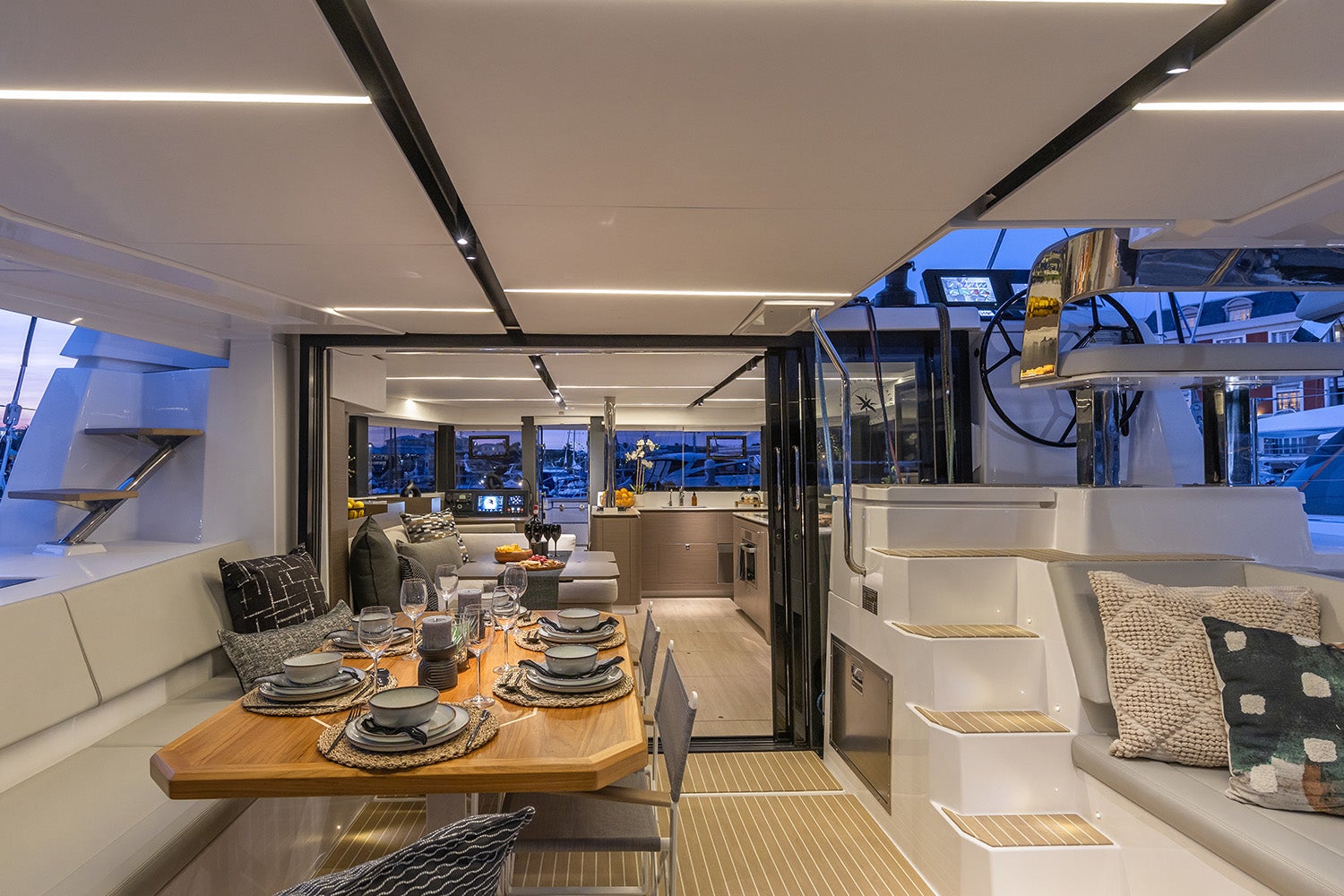
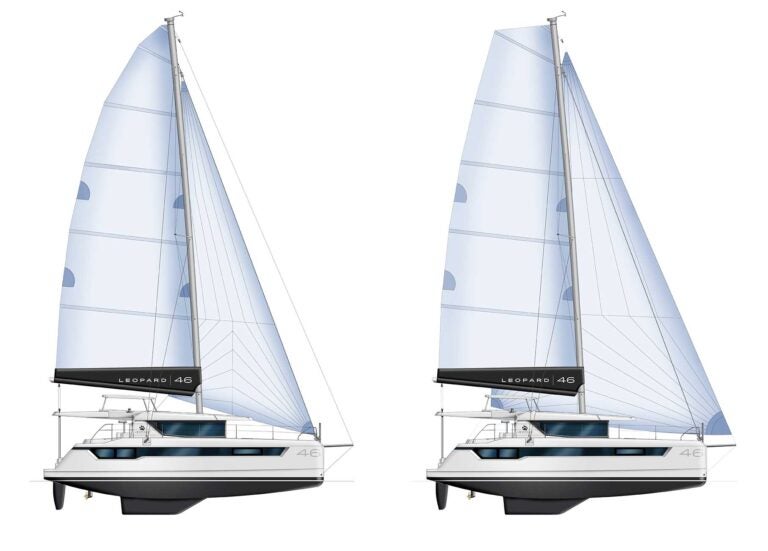
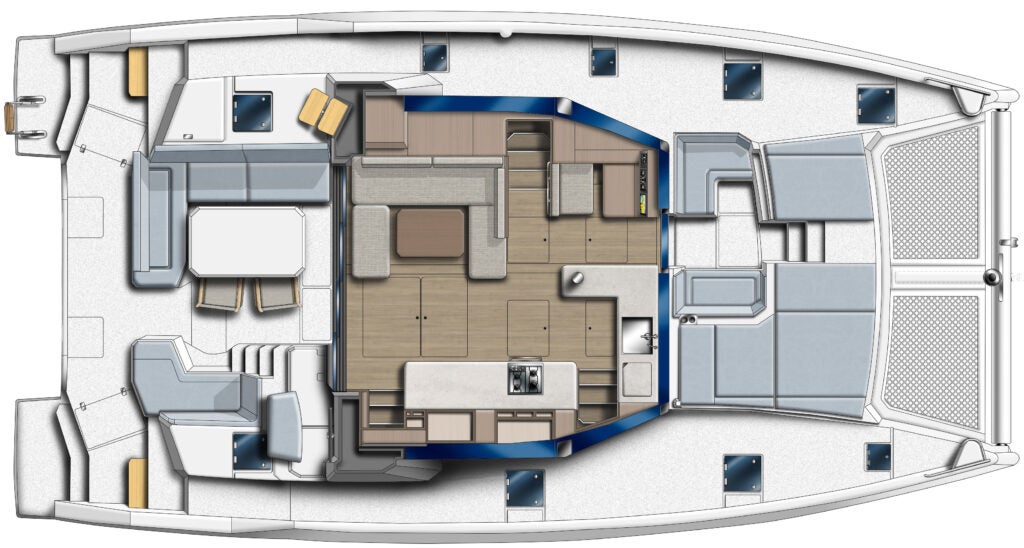
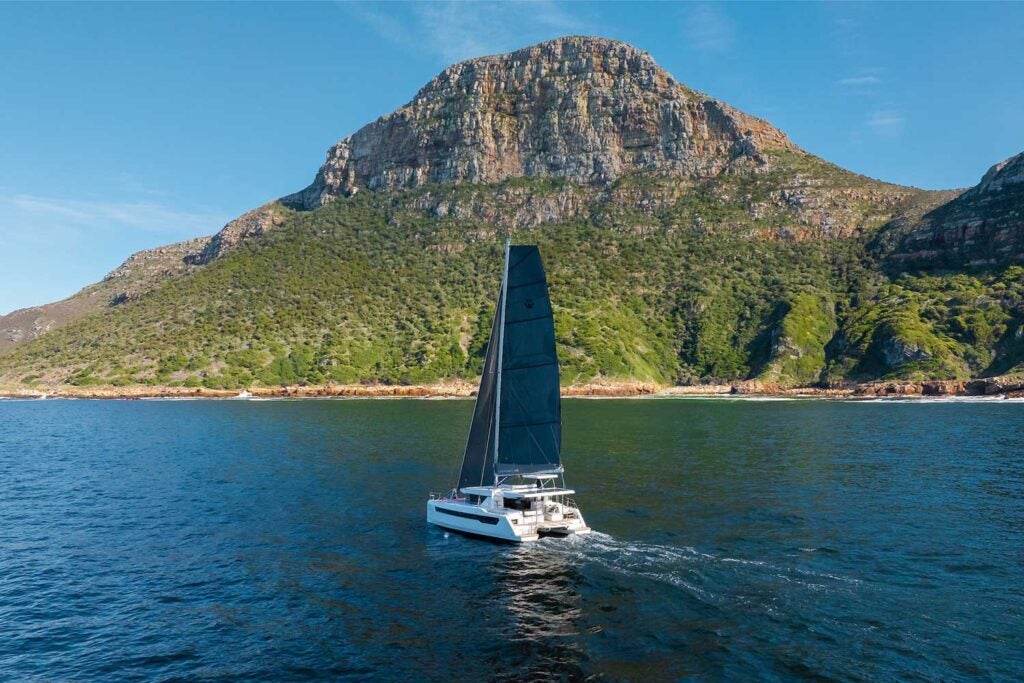
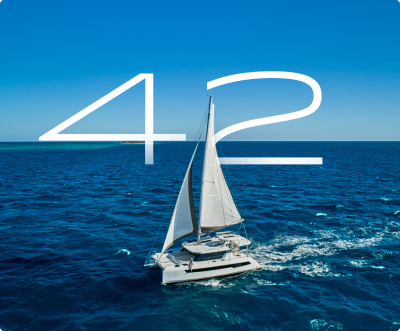







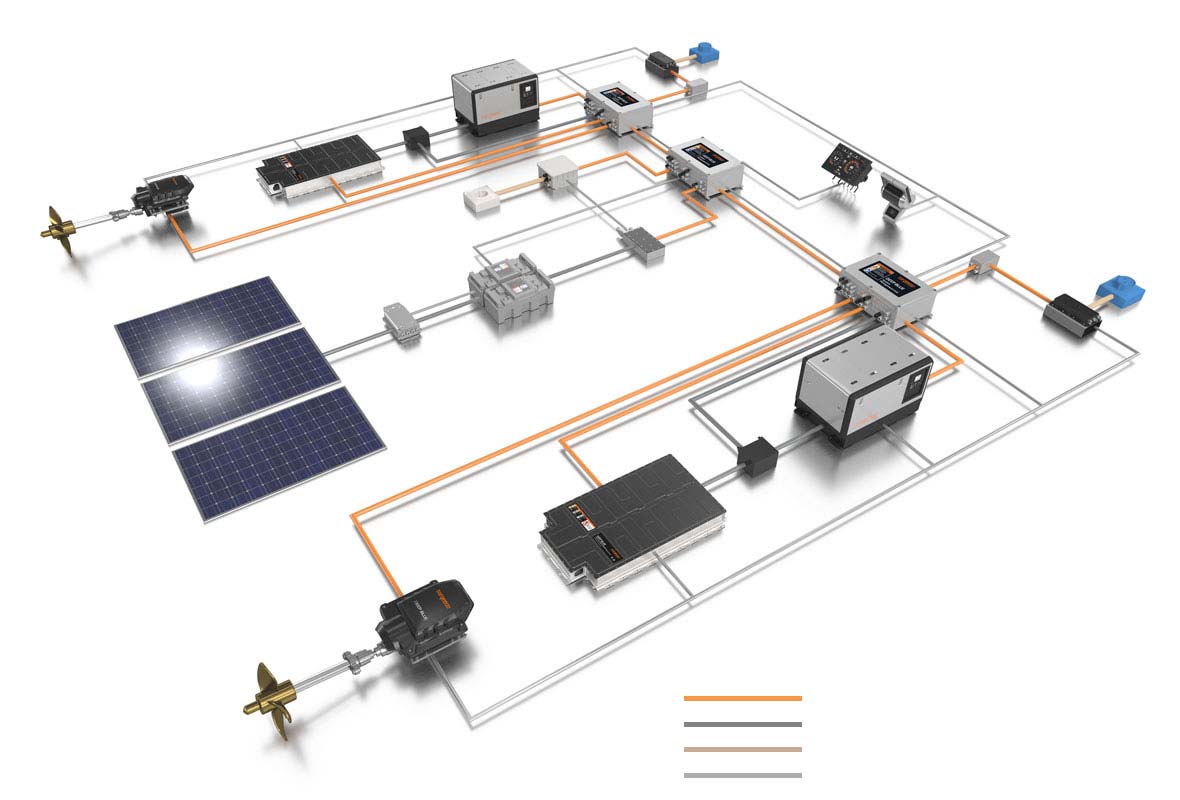
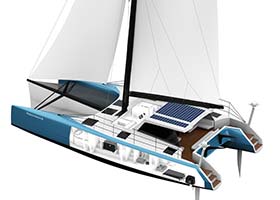

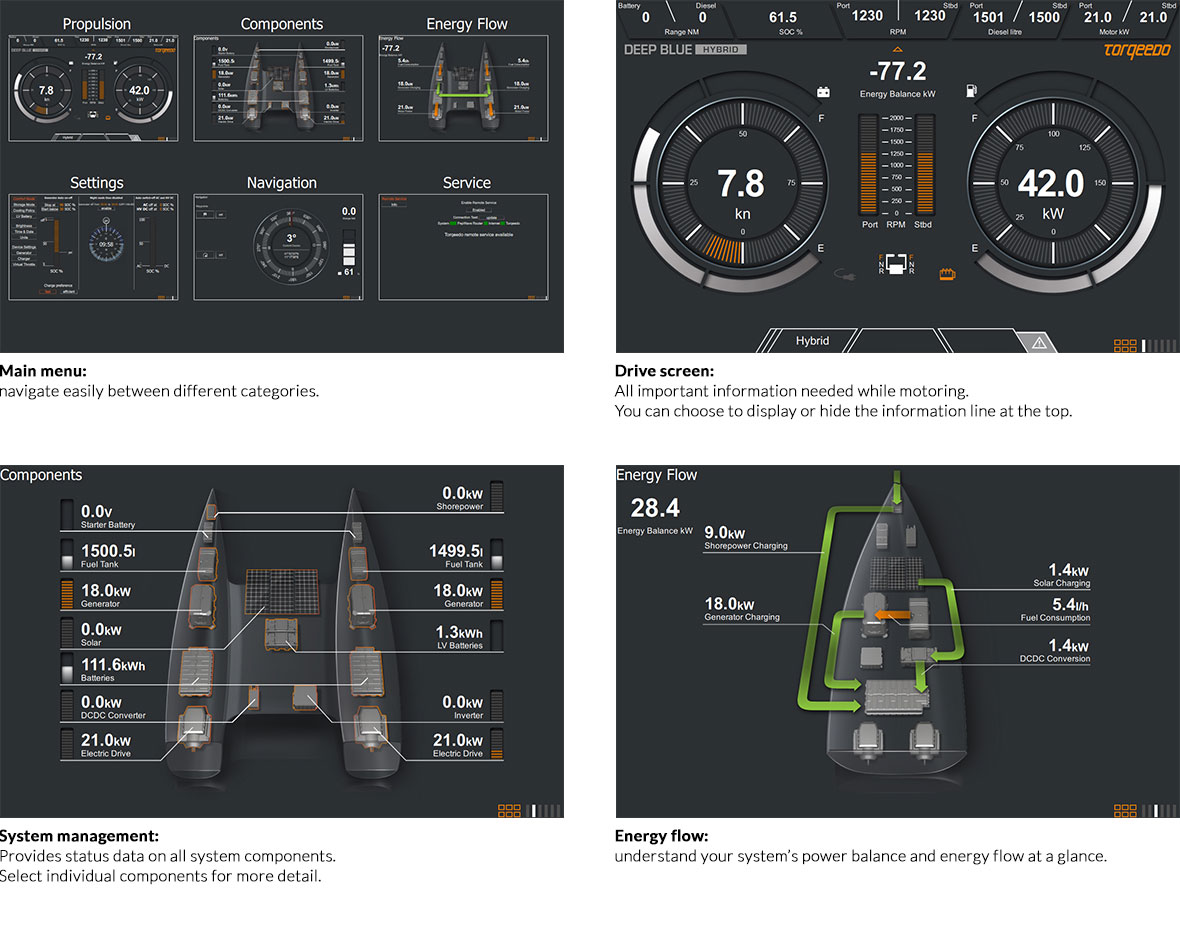
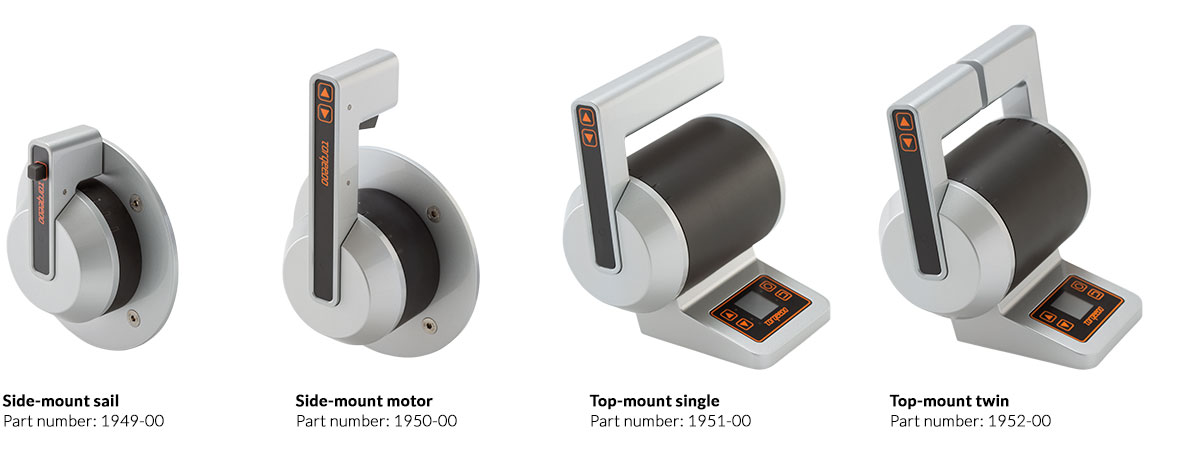
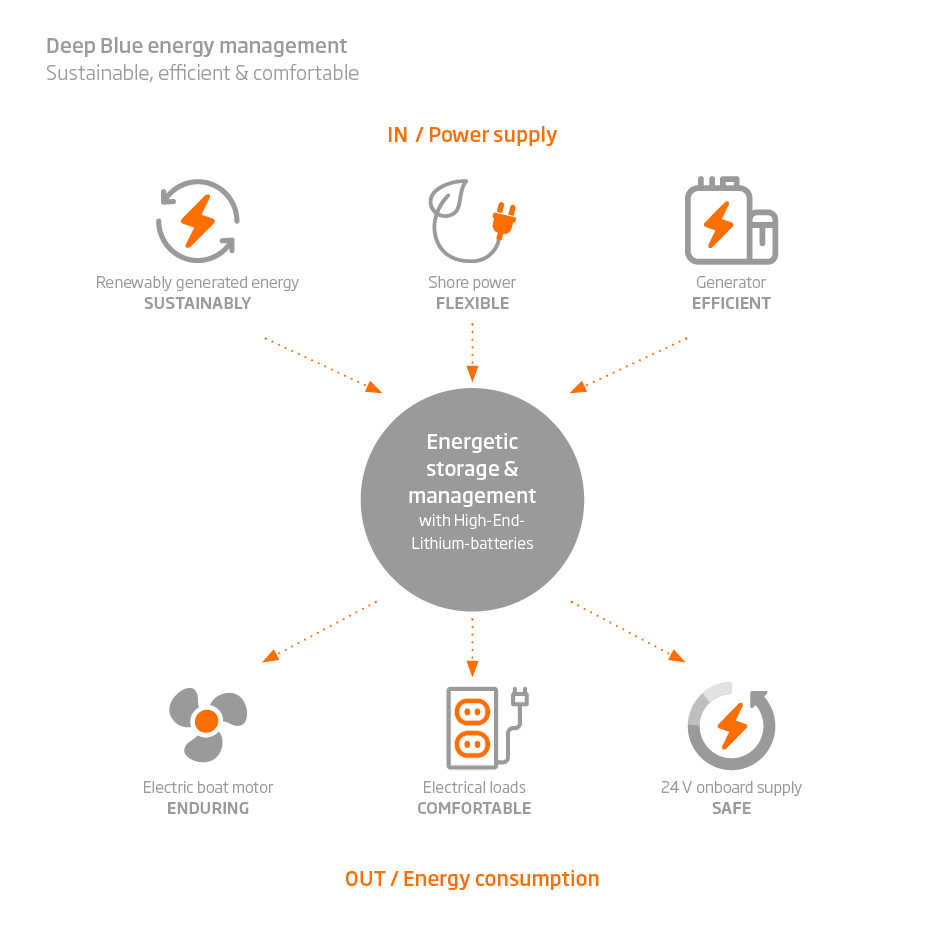

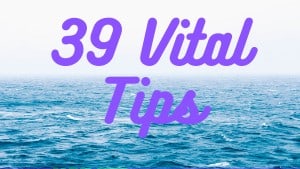


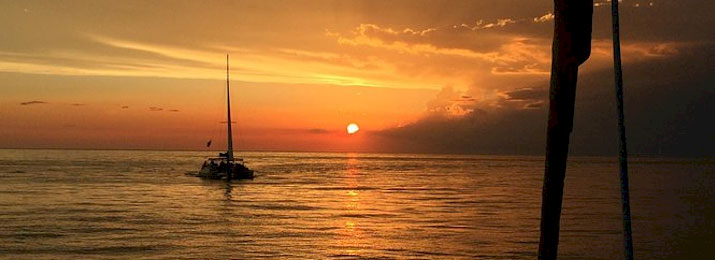


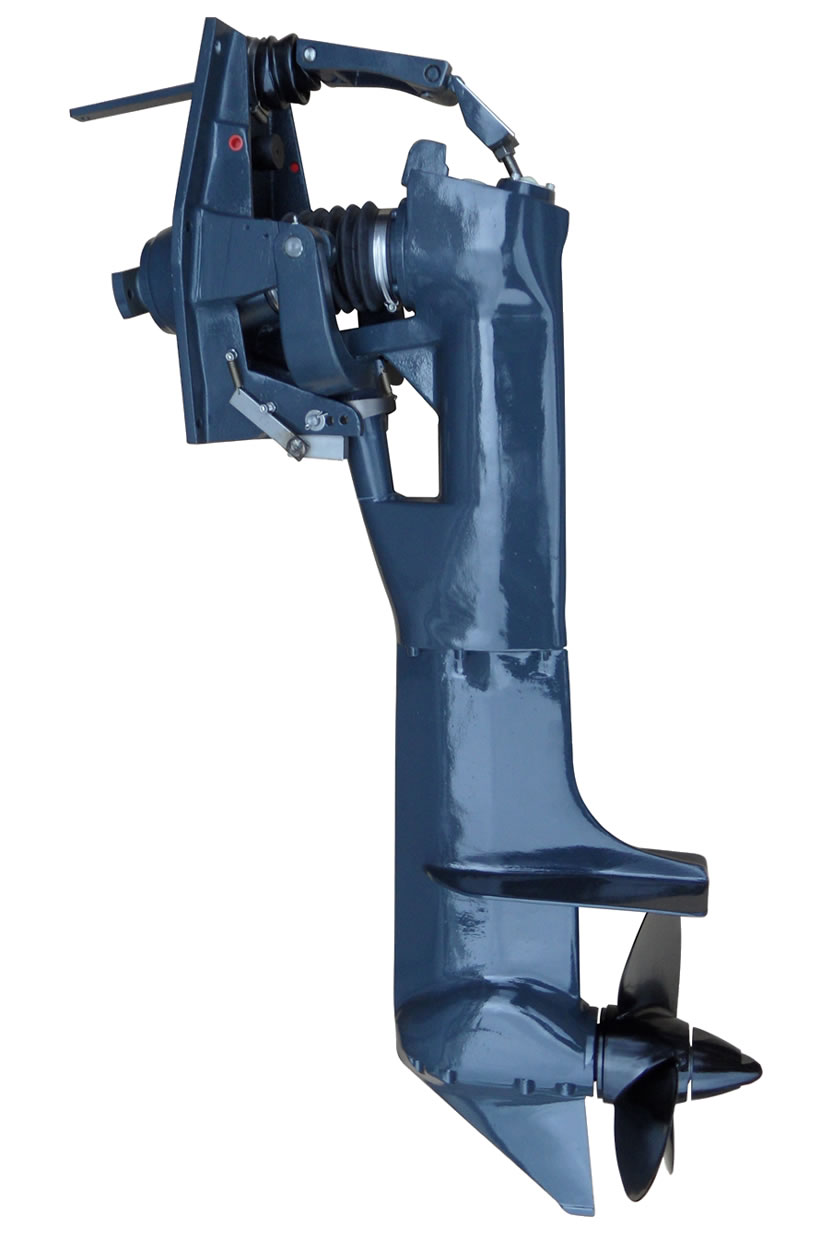
IMAGES
VIDEO
COMMENTS
A hot topic these days is that of the buyer of a straight shaft engine, or the other guy who would like a saildrive unit instead, on his catamaran. Traditionally, there are more straight shaft drive monohulls and more catamaran's built with saildrives today. This rule tends to go out the window on vessel's over 50 feet.
Sail-powered catamarans especially benefit from their ability to harness wind, but this can make them tricky to drive in strong winds when compared to monohulls. Key Differences in Driving a Catamaran. Speed and Efficiency: Catamarans glide across the water with minimal drag, making them more efficient and often faster than their monohull ...
A good example of this is the evolution of the Leopard 47 (a straight shaft boat) to the far superior sailing Morelli and Melvin designed Leopard 46 (a sail drive boat.) Sail drives offer more horsepower at the prop. Sail Drive Negatives. Sail drives generally cost more to replace than shafts. The typical drive leg for a 40 to 50 foot cat is ...
Photo courtesy Volvo Penta. The flexibility of the saildrive configuration on a new hull design is compelling. The fact that the engine and drive system form essentially a single unit eases installation, and by design can keep weight "out of the ends," which is always desirable with sailboats. With the saildrive, the weight of a shaft ...
A somewhat unique option is the Sillette Sonic drive (common on Gemini 105 catamarans) which is a type of saildrive. It allows using an inboard engine with an outboard drive leg exterior to the boat. The drive leg can be raised while under sail, providing the same no drag advantage as outboards, while having the engine inboard which protects it ...
Here are some handling tips that apply to handling both sail and power catamarans. Don't Ding The Dock. When there's no wind, bigger sailcats also have an engine, which is needed in each hull. They aren't powered to drive as fast, but the principles are the same. Keep in mind, boats and conditions are varied, so we can only give examples here.
Whether you are buying a monohull or catamaran, understanding the difference between shaft drives and saildrives is important!
Sail Drives. Saildrives are often used on catamarans as they result in a very compact drive system. Multihulls have narrow hulls, so there's not enough room to walk around an engine, as there is on most monohulls. So a catamaran's engines are usually under the aft bunks, which usually doesn't leave much room for a gearbox, propeller shaft ...
A shaft drive propulsion system is far superior, especially for a global cruising yacht. While a sail drive installation of a compact unit of engine and drive train offers some advantages for convenient and relatively inexpensive installation by the builder, the advantages of a shaft drive are critical for a true blue-water global cruising catamaran.
Find Sail Catamaran boats for sale in your area & across the world on YachtWorld. Offering the best selection of boats to choose from. ... (960) Sail Drive (960) Stern Drive (13) Stern Drive (13) Surface Drive (1) Surface Drive (1) V-drive (18) V-drive (18) Fuel. fuel-diesel. Diesel. fuel-electric. Electric. fuel-other. Other. fuel-gas. Petrol ...
The new YANMAR SD15 saildrive, developed by partner ZF, is now available with the 4JH80 and 4JH110 engines, with the 4LV150-SD15 solution scheduled for launch in Q3 2022.. Suitable for a wide range of applications, the latest YANMAR saildrive propulsion systems provide a new option for a vastly extended range of sailboats and catamarans, using engines from 80 HP upwards that have previously ...
The new Leopard 46 sailing catamaran represent a significant upgrade from its predecessor, the Leopard 45. Building upon the successful DNA of Leopard catamarans, this new model offers a spacious, robust, and high-performing cruising experience. ... Same assemblyas sail drive. Battery Pack. EFFICIENT BATTERIES - High-speed lithium iron ...
The safest cruising catamarans offer a good beam to length ratio, sail fast, and are over 42ft. These include the Manta 42, the Lagoon 450F, and the Catana 44. They are stable, waterproof, easy to handle in stormy weather, and feature a sturdy design. When boarding a boat, you expect to get to your destination safely, and with your bluewater ...
Owned Crowther 33 for 5 yrs. Equipped with pair of Yanmar shaft drive 2GM20's (actually 18 HP's) No problems for that time. Now have a Tennant 47 with 3GM 30's & saildrives. Because of shaft drive the engines were under the bunks - so far from ideal. The seals were well back and rather difficult to get out. With sail drives the engines are out the back in their own engine "rooms" and easy to ...
The popularity of pod drives has been on the rise for years, as more boat owners have left struts and shafts behind for these steerable drive units. But the love affair is one that's been enjoyed primarily by owners of monohulls. Sunreef Yachts of Poland recently broke new ground by powering its 60-foot power catamaran with Volvo Penta's IPS800 pod drives, and the installation has been so ...
Short Answer. Sailing a catamaran is relatively straightforward. To get started, adjust the sails and rudder to the desired angles. Next, begin to move forward using the power of the wind and the force of the sails. While underway, make sure to constantly adjust the sails and rudder to maintain the desired course.
Powerful electric motor: delivers between 25 and 100 kW of continuous power at 360 V. Available as inboard, outboard or saildrive. 2. 360 V high-capacity lithium battery system. 3. 12 V batteries: system power supply for starting up the high-voltage battery system and the diesel generator. The Deep Blue system manages these batteries autonomously.
The point of sail defines the direction of the wind relative to your cat. With the right point of sail, you will be in a position to sail your catamaran smoothly. The point of sail differs depending on the angle of your cat from the wind. The different points of sail include: Running: In a running point of sail, the wind blows behind your back ...
Catamaran Sailing Techniques: Everything you need to know - Yachting World. The wind will give you a hard time. A catamaran is basically a big box with floating sleds; boxes are not famous for aerodynamics. This box-shaped floater will catch a lot of wind and will make slow speed movements, such as docking, a little bit trickier.
The HH44-SC integrates the very latest in race boat technology but remains equally as comfortable as a family cruiser. This is a "no-compromise-boat" with C-shaped carbon daggerboards, a carbon rig, a painted hull finish, expanded solar array and EcoDrive as standard equipment. Contact our sales team to receive detailed specifications.
Save time and money! Buy tickets now to guarantee your spot! Available: Between 4:30 - 6:30 PM. Departure times vary depending on time of sunset. View available departure times upon booking. Duration: 2.0 hours. Location: 4114 Jan Cooley Dr, Panama City Beach, FL 32408, USA. SAVE UP TO $5.00 OFF SUNSET DOLPHIN CATAMARAN SAIL!
Sonic Type 2. SONIC TRANSMISSION UNITS are designed with service in mind. The rugged, but well engineered construction enables complete overhauls to be carried out with minimum tools, which is a facility not always possible with other "mass produced" drives. 6-50 bhp Petrol. 6-37 bhp Diesel.
Set sail on your destination's top-rated boat tours and cruises. Whether it's an entertaining and informative boat tour or a relaxing sunset dinner cruise, these are the best Moscow cruises around. Looking for something more adventurous? Check out our list of must-do water activities in Moscow. See reviews and photos of boat tours & water sports in Moscow on Tripadvisor.